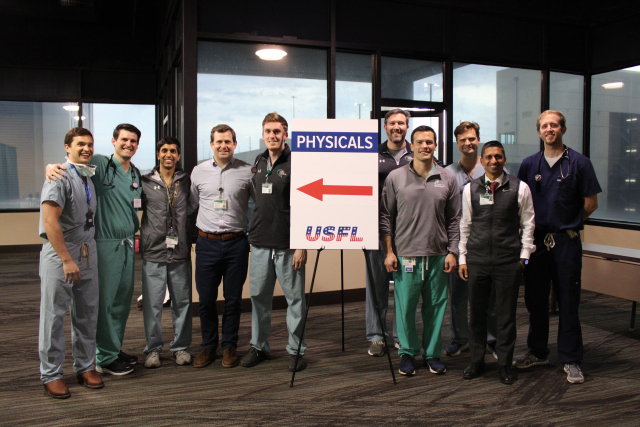Ask a Provider Series: March Recap
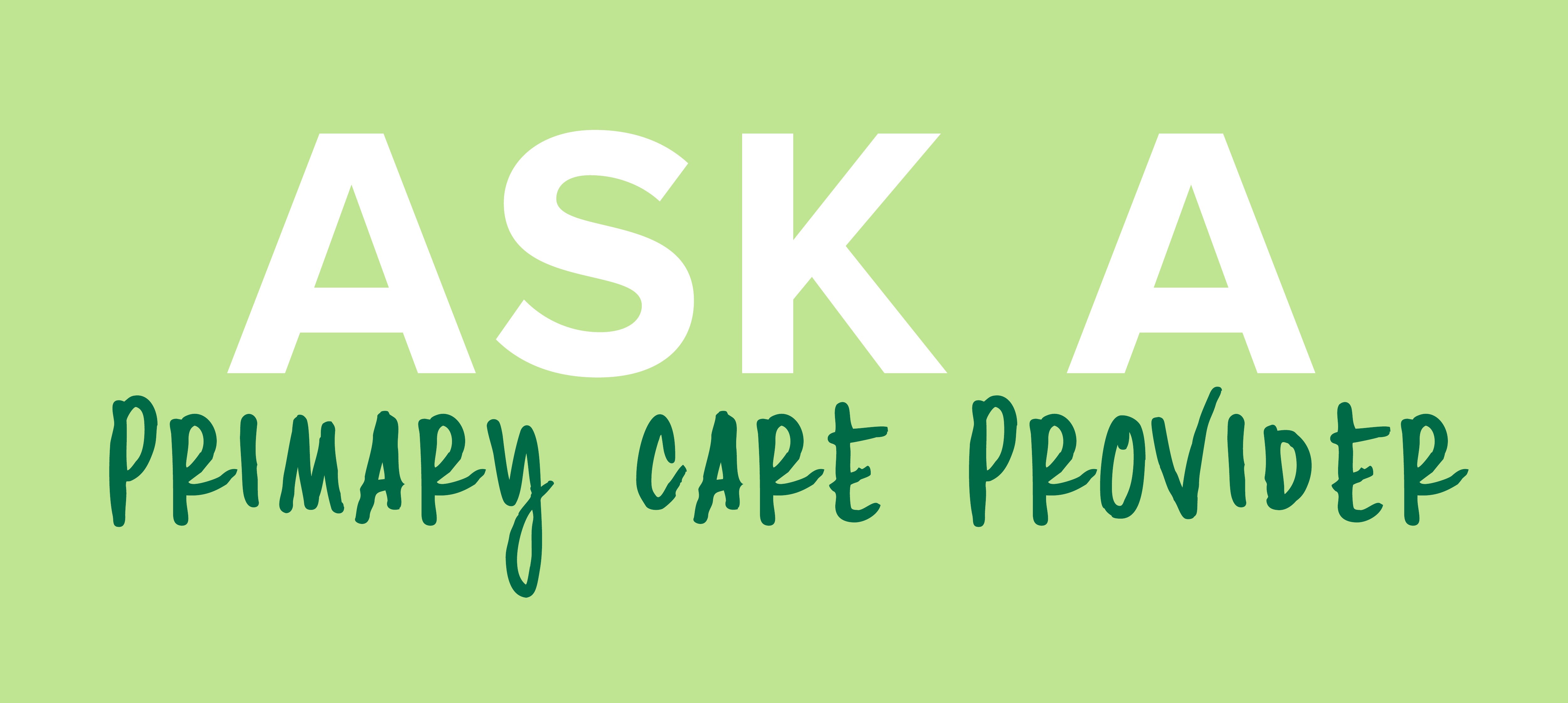
Written by Kenia Hernandez
Asking your doctor questions and being informed is an important part of being an active participant in your health. Over the last four weeks, family medicine physicians in the UAB Department of Family and Community Medicine shared their answers to some of the most common questions that patients have. Here is a recap of the questions covered in March:
1. I want to eat healthier but don't know where to start. What are three foods I should eat that would make my diet better?
Having a healthy diet lowers your risk of serious health conditions such as heart disease, diabetes and obesity. Eating healthier is a critical part of your health, but figuring out what foods are best to eat may be overwhelming. Caroline Cohen, Ph.D., R.D., assistant professor, recommends adding avocado, berries, and Greek yogurt into your diet. Cohen notes that avocado is high in healthy fat that improves heart health, and they are rich in potassium and magnesium.
“Berries are a great concentrated source of antioxidants, which help protect our body’s cells,” Cohen said. “They are also among the lowest in sugar content and highest in fiber, making them a great choice for managing blood glucose.”
Cohen noted that Greek yogurt, contains live active cultures (probiotics), which are important for gut and immune health, and a great source of protein.
2. What's the deal with supplements? Should I be taking them and if so, which ones?
Supplements include probiotics, vitamins, minerals, enzymes and amino acids. Supplements come in many forms such as pills, powder and liquid. Kim Fagan, M.D., sports medicine division chief and assistant professor, shares her answers about what supplements to take:
"Ideally, we would all get our needed vitamins and minerals through a nutritious diet, but the reality is that nine out of 10 Americans don't get the recommended 4-5 servings of fruits and vegetables per day that supply those vitamins and minerals,” Fagan said.
Supplements can help fill the nutritious gaps in patients’ diets. Fagan notes that a multi-vitamin is a good place to start, as well as considering a vitamin B complex and vitamin d3 supplement.
“Different stages of life also require more or less of something-- so talk with your doctor about specific needs for your age, reproductive or personal health goals," Fagan said.
3. What is the best type of exercise for a beginner to try?
Exercising has many benefits including combating health conditions and diseases, such as diabetes, hypertension and depression. Exercising can also boost your energy, improve your mood and help you maintain a healthy weight. Calvin Spellmon, Jr., M.D., sports medicine physician and assistant professor, shares his advice regarding the best type of exercise for beginners.
“Walking is the best type of exercise for anyone to try, especially beginners because you can go at your own pace. Spellmon said. “You don't need any fancy equipment or a gym membership and it can be done literally anywhere.”
Spellmon notes that most people complete this exercise whether they want to or not. Spellmon suggests recommends walking on soft surfaces, wearing supportive shoes and orthotics if needed, and drinking fluids.
During your exercise make sure you warm-up and stretch before and after, gradually build up your distance and ice for recovery if needed. Spellmon recommends wearing bright colors for safety, keeping headphone volume low, avoiding high traffic areas, and letting someone know the route you are on.
4. As a woman, which screenings should I be talking to my doctor about?
Screenings and tests can spot critical conditions and diseases early on and are a major factor in preventive care. Female patients should know which screenings are recommended for them and when they need to get them. Erin DeLaney M.D., assistant professor and vice-chair of clinical afairs and quality and medical director of UAB Family and Community Medicine Clinic at UAB Hospital-Highlands shares her answers regarding women’s health screenings:
"Female patients should talk with their provider about the following important screenings: cervical cancer, with pap smears starting at age 21 and then every three to five years based on age and risk factors,” DeLaney said. “Breast cancer, with mammograms starting as early as age 40 for some women; and sexually transmitted diseases (STD), for those who are sexually active.”
DeLaney also suggests osteoporosis with bone density studies starting at age 65 or younger depending on risk factors; and skin cancer, hypertension and depression screenings.
The providers of the Department and Family Community take pride in answering your health needs and concerns including advice for a healthier diet, supplements, exercising and preventative screenings. Be on the lookout for more answered common health questions. For more helpful answers, follow the department on social media.
UAB Sports and Exercise Medicine Team Provides Physicals and Medical Exams to USFL Players Ahead of Regular Season Coverage
In preparation for the United States Football League (USFL) kickoff game on April 16, the UAB Sports and Exercise Medicine team, along with other UAB providers and volunteers, performed preseason physicals for the nearly 400 players who arrived in Birmingham in March.
UAB Sports and Exercise Medicine will be the medical provider for the USFL during its inaugural 2022 season.The USFL is a professional football league that includes eight teams, divided into Northern and Southern divisions. All teams will play their regular season games in Birmingham, Alabama.
UAB providers and volunteers performed various exams for the players, including eye, EKG and concussion baseline exams, along with full physicals. UAB Sports and Exercise Medicine providers will also provide sideline medical coverage during all regular season games this year.
“It is an exciting time to be a sports medicine physician in Birmingham,” said Irfan Asif, M.D., chair of the Department of Family and Community Medicine, sports medicine physician and director of UAB Medicine’s Primary Care Service Line. “Our talented group of providers will be able to serve the USFL with comprehensive medical care, ensuring they are at their best on and off the field.”
Asif will serve as medical director for the league and will lead the USFL Medical Advisory Committee, made up of seven members from a variety of health-related disciplines. Two sports medicine providers from the Department of Family and Community Medicine will also serve as lead team physicians. Ian McKeag, M.D., M.S., director of the UAB-Cahaba Sports and Exercise Medicine Fellowship program, will be the head team physician for the Michigan Panthers, and Calvin Spellmon, M.D., will be the head team physician for the Pittsburgh Maulers. All members of the UAB Sports and Exercise Medicine team will support the team through sideline and outside medical care.
UAB Sports and Exercise Medicine, a partnership between the Departments of Family and Community Medicine and Orthopaedic Surgery [need PMR?], includes a team of experienced sports medicine physicians and orthopaedic surgeons that are able to provide top-level care that addresses every facet of personal wellness for the athletes. Medical team members also include personal trainers, dietitians, rehabilitation specialists and more.
“We are pleased to support the USFL, all of its teams, and all of its players,” said Amit Momaya, M.D., associate professor and section chief of Sports Medicine in the Department of Orthopaedic Surgery. “This is a gifted league of players who will get the best possible medical care from our team.”
To learn more about UAB Sports and Exercise Medicine, visit their website.
Female Providers Reflect During Women's History Month
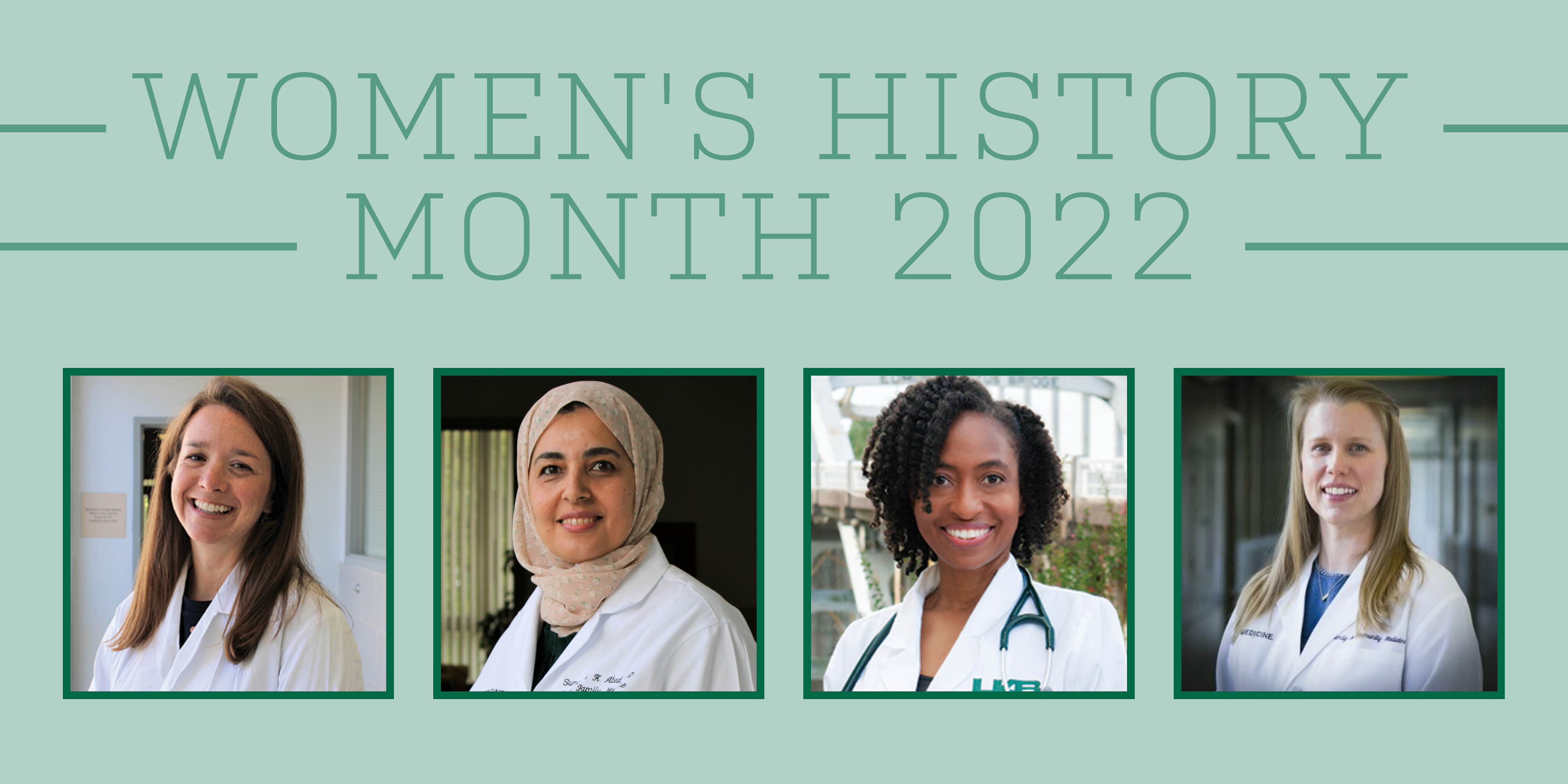
The number of women physicians has risen significantly in the last 15 years, according to a report from the Associate of American Medical Colleges. Since 2007, there has been close to a 10% rise in the number of women physicians. Additionally, numbers now show that half of all medical students are women. With such steady growth in the number of women entering medical careers, several female providers in the Department of Family and Community Medicine came forward to share their thoughts and advice for current and future women in medicine during Women’s History Month.
Of those who shared, half have been practicing medicine for more than seven years and half are early career practitioners (1-3 years of practicing at UAB). We asked each of them to provide a summary of what being a woman in medicine means to them.
What does being a woman in medicine mean to you?
“Although there are a lot of challenges—work-life balance and taking care of kids and my husband—I am proud of being a physician,” said Sumayah Abed, M.D., assistant professor and provider at UAB Hoover Family Medicine.
Erin DeLaney, M.D., assistant professor, vice-chair of clinical affairs and quality and medical director for the UAB Hospital-Highlands Family and Community Medicine Clinic, noted that being a woman in medicine meant sacrifice and building relationships.
Tiffani Maycock, D.O., associate professor and director of the UAB Family Medicine Residency in Selma, said that being a woman in medicine felt like a privilege to her.
“I listen to the radio program ‘Your Story Hour’ with my boys and some of the historic stories about women in medicine in the early years when there were numerous obstacles to women becoming physicians ... I am honored to have the opportunity,” she said.
All agreed, as Kaylee Crockett, Ph.D., assistant professor and clinical scientist, put it, that being a woman in medicine meant providing excellent care to patients by bringing their unique perspectives to their practice.
What barriers do you see to being a woman in medicine? How can we work toward removing these barriers?
Crockett pointed out the intense pressures and high expectations put on women to “do it all” as providers, partners, mothers, educators, scientists and more.
“The primary barrier is the expectation that women ‘do it all’ exceptionally, compassionately and without support... Women very often leave medicine because of these demands and the shame that comes with not meeting them,” she said. “We need women in seats in leadership to design supports to retain women.”
Maycock, as a Black woman and physician, sees and regularly works against the racial disparities that are a barrier to many women of color in medicine.
Both DeLaney and Abed commented on barriers that might keep women from leadership roles, or the impact of having only male predecessors, and expectations, in assuming leadership positions. DeLaney is the first female vice-chair in the department’s history.
What advice would you give to your younger self? What do you hope for yourself as you continue in your career?
Abed encouraged herself, past and future, to be creative and ask for her rights to be considered when growing in a position of leadership.
“We can do hard things and excel at them, but it is ok to ask and accept help along the way,” noted DeLaney when thinking about her younger self. She hopes to give herself grace to make time for what is important to her as she continues in her career.
Crockett expressed hope that younger women would savor the path to achieving their goals instead of always looking to the next step. For her older self, Crockett wants to be a mentor and advocate for other women that want to become leaders in academic medicine.
“Find a career mentor early and set an intentional career path,” said Maycock to her younger self or women just starting out. She wants to set reasonable goals and boundaries in the future to ensure her own personal and professional success.
What inspires you as a woman in medicine?
Nearly all of the providers listed seeing the impact of their care and relationships with patients as inspirational. Some listed the joy of seeing women succeed and becoming advocates for themselves in the medical community.
Abed, in sharing what inspires her, noted a combination of what others shared:
“I can take care of women patients and understand them physically and emotionally because I am one of them.”
The department honors and acknowledges the vital contributions of all of our female providers and staff. For another Women’ History Month story, click here to read about important health tips that two of our female providers share for women to consider.
New Family Medicine Residency Track Offers Opportunities in Alabama’s Black Belt
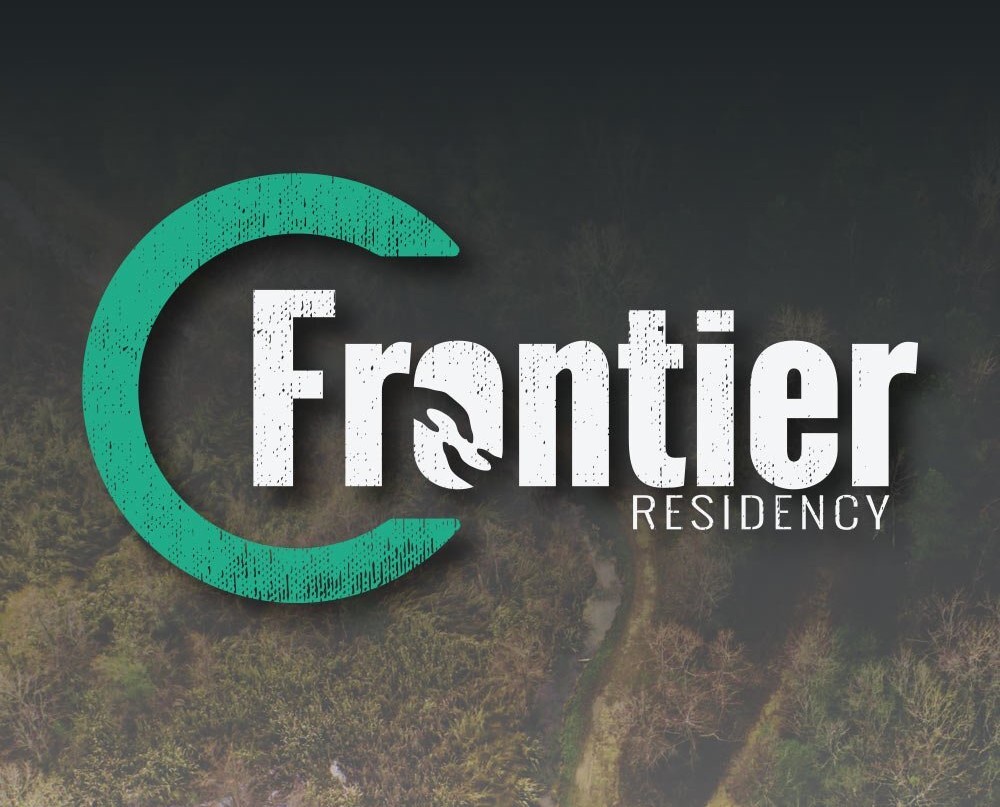
This summer, residents in the Cahaba-UAB Family Medicine Residency will be able to enroll in a new “Frontier Track” placing residents in clinics and hospitals in Alabama’s Black Belt.
The track, which was accredited in May 2021 and will matriculate its first class of four residents in July, complements the Cahaba-UAB residency’s existing Urban and Rural tracks, based out of Birmingham and Centreville, respectively. Currently, the program hosts 36 residents (12 per year) across the urban and rural tracks.
John B. Waits, M.D., Cahaba’s chief executive officer and director of the family medicine residency, said the Frontier Track is designed in part to address critical health care shortages in the Black Belt area of the state.
“This area of central Alabama has fairly intractable health care disparities and some of the deepest health professional shortages in the state,” Waits said. “We know the more local that you make training, the better recruitment and retention that you get,” as health care professionals stay in areas where they trained.
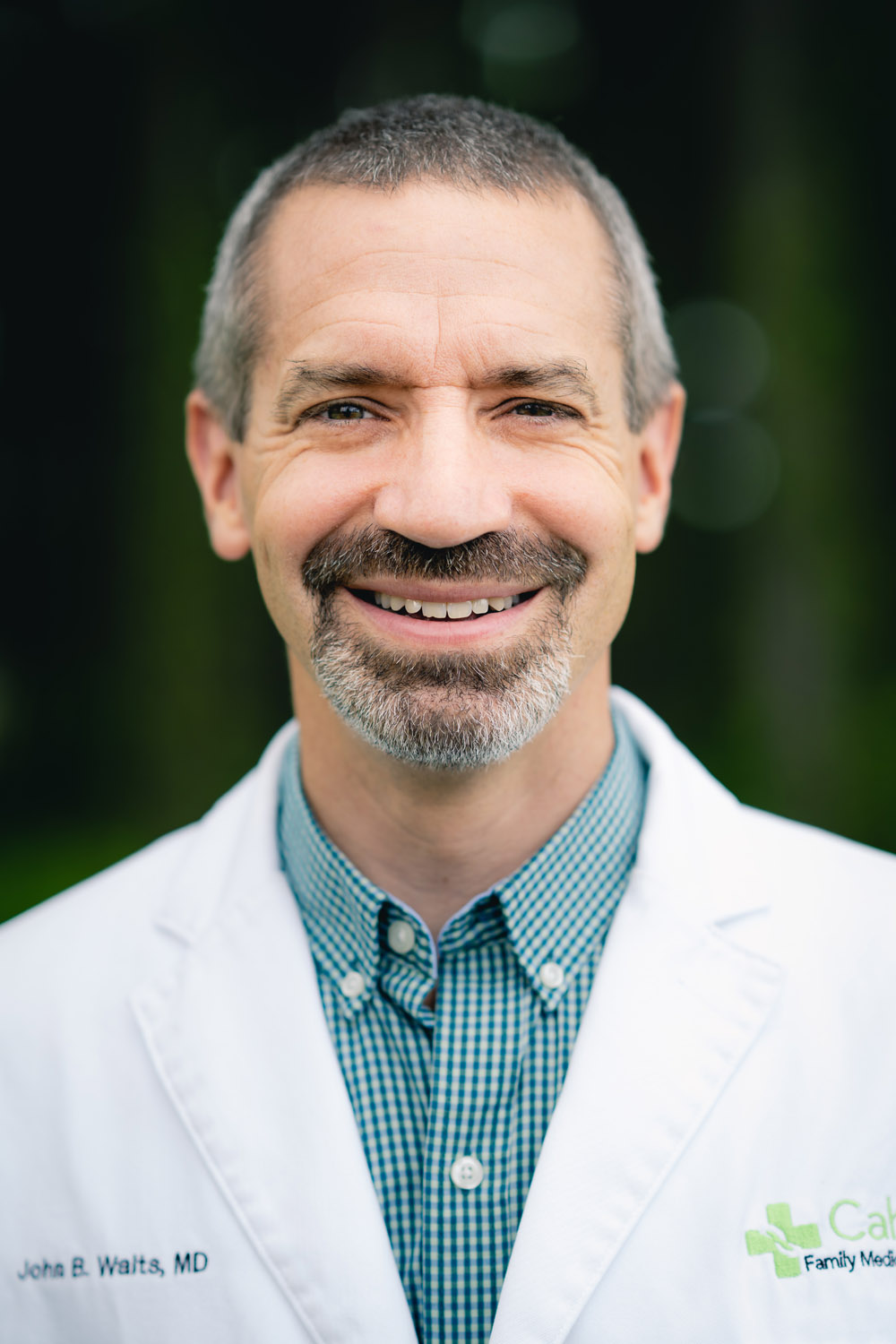 John Waits, M.D.
John Waits, M.D.
Waits points to previous success the Cahaba program has had in Bibb County, where the program opened a location in 2004 and a residency in 2013.
“We have graduated multiple residents from that program and Bibb County is now on the verge of not being a health professional shortage area for the first time in decades,” Waits said.
Overall, 68% of all graduates of the Cahaba-UAB Family Medicine Residency work in underserved communities, compared to a 26% national average of family medicine graduates. Fifty-five percent work in Alabama, and 21% work in rural communities, compared to a 5% national average.
Frontier Track Format
The new Frontier Track will feature a PGY-1 year at Cahaba Medical Care in Bessemer in collaboration with UAB Medical West. The PGY-2 year will consist of an innovative, longitudinal, integrated curriculum in Alabama’s Black Belt at Cahaba Medical Care in Marion and Sumpter Blackmon, M.D.’s, clinic in Camden. Blackmon joined Cahaba Medical Care in 2022.
In addition to working in the clinics, Frontier Track residents will complete their hospital hours at J. Paul Jones Hospital in Camden, a UAB Health System member hospital that has been serving Camden, Wilcox County and surrounding communities since 1957. Residents will also work at UAB’s hospital, rotating through obstetrics, emergency medicine and other areas.
Lauren Linken, M.D., and Laura Lishman, M.D., will serve as interim co-directors of the Frontier Track.
Leaders hope that bringing more family medicine residents into Alabama’s Black Belt – typically defined as 12 counties stretching across central Alabama – will help address challenges in the historically agricultural region, which faces high poverty rates, high rates of chronic illness and numerous barriers to health care access, including a lack of primary care physicians. Family medicine residents will also have an important chance to give back to and learn from the communities where they are practicing – often addressing health disparities that have hit close to home in their own lives.
“Many people go to medical school and residency in order to go back to their hometowns, where they have seen health care shortages, and ask how they can be part of the solution,” Waits said. “In the Frontier Track, they will learn the skills necessary to be a physician in an area without many physicians – how to handle referrals, or pursue training or help patients find what they need.”
Cahaba-UAB family medicine residents are trained in the maximum number of procedures that a family medicine doctor can do in a clinic, including orthopaedics, cardiology procedures, ultrasound, dermatology and more. That experience prepares family medicine residents to meet a wide variety of patient needs – a critical skill in areas where they might not have access to specialists.
The residency will also partner with numerous local organizations, including churches, nonprofits and stakeholder groups formed to advise the program. Often, clinics where residents work will provide free or reduced-cost services, as well as rotating complementary services such as food pantries or clothes closets for local residents in need of those items.
"Leaders, faculty and staff at the Cahaba-UAB residency do a fantastic job bringing high-quality care into communities across Alabama, and I am proud to see that continue in the establishment of the Frontier Track,” said Irfan Asif, M.D., chair of UAB Family and Community Medicine, associate dean for primary care and rural health and head of UAB’s primary care service line.
“Addressing care shortages in areas like Alabama’s Black Belt is critical to the future of our state, and to making Alabama a healthier place for all Alabamians.”
Department Offers Two Spring Elective Courses to Medical Students
Department of Family and Community Medicine team members are leading two elective courses relating to teaching and interprofessional practice as a part of the Heersink School of Medicine’s spring 2022 curriculum. These courses allow students to hone in on their interests and explore new ideas related to their future medical careers.
Teaching in Medicine
Michael Wiederman, Ph.D., professor and director of the department’s Office of Leadership and Professional Development leads the course “Teaching in Medicine”. Wiederman teaches this course to 20 students, including students in their second, third and fourth years of medical school. The course helps students understand the importance of teaching in the classroom and inpatient and outpatient clinical settings.
The course includes brief readings and videos for students to review before the virtual class session, where Wiederman leads discussions and puts students into breakout rooms for small group conversations and activities.
“It is this adult learning theory idea that we take the most value from something when we apply it to ourselves, we have a chance to discuss it and we think about what's most relevant to us,” said Wiederman.
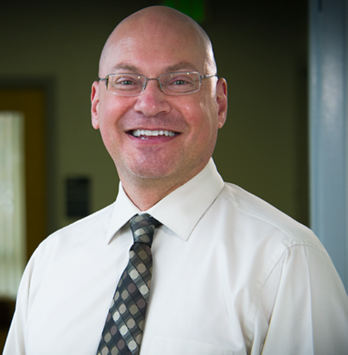 Michael Wiederman, Ph.D.
Michael Wiederman, Ph.D.
Wiederman said that most of his students are interested in working with learners in their future careers. This course will help them later during residency, when they will be teaching medical students, he notes.
“I've been very impressed with how involved and invested these students are in becoming better teachers, even at this early stage of their career,” said Wiederman. “I think I’ve made them more aware as learners about what works and what doesn't work.”
Even if these students do not go into teaching, this course has made them better at learning what they need to do to prepare for interactions with learners. Wiederman notes this course is like peeling back a curtain and showing the students a behind-the-scenes view of what good teachers should be thinking about and why they include certain instructional methods such as case-based, lecture, gamification or simulation learning.
Hana Habchi, a student in the Department of Family and Community Medicine’s Comprehensive Urban Underserved and Rural Experience program, is in Wiederman’s course this spring. Habchi said the course helped her learning and development.
“Dr. Wiederman’s class has opened my eyes to the many different strategies that exist in education,” Habchi said. “Our group’s discussions have revealed just how impactful our instructors' teaching decisions are on our learning. In many ways, it has helped me be a better student. It feels like we are getting a behind-the-scenes look at course design."
Foundations of Interprofessional Practice
In addition to Wiederman’s course, Kala Dixon, Ph.D., director of the Office of Interprofessional and Continuing Education, is teaching “Foundations of Interprofessional Practice” this semester. This course focuses on the foundation of interprofessional practice – through modalities of conceptual application within team-based model building projects.
Each week the students focus on a different topic, adding another element to their “clinic model” that they are designing as a team. There are 11 students in three groups creating their own clinic model on a platform called "Edu Blog." Each group manages their clinic blog housed within the course blog, which is operated by Dixon.
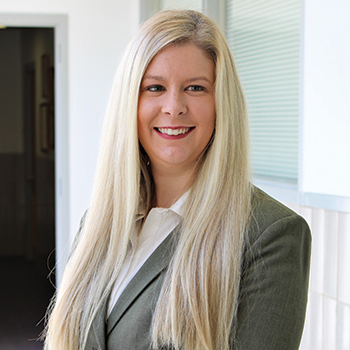 Kala Dixon, Ph.D.
Kala Dixon, Ph.D.
This course includes required readings prior to coming to the virtual lesson, where Dixon lectures about Interprofessional Education Collaborative (IPEC) principles and leads roundtable discussions. During the final hour, students split into breakout rooms with their designated groups to focus on that week’s topic and blog post.
The first few classes consist of students layering in the basic foundations of clinical structure from a provider standpoint. Their clinics included physician assistants, medical practitioners, medical assistants, several technicians, dieticians, social workers, and pharmacy. They focus on the building blocks of interprofessional practice instilled within the IPEC core competencies, including roles and responsibilities, teamwork, valuing ethics and communication. Additionally, students also layer in aspects of clinic structure and operation related to creating their clinic’s mission, vision, and value statements, clinic policies, regulations, clinic funding, interprofessional team training, employee performance evaluation systems, and patient feedback surveys, to name a few.
Dixon notes interprofessional practice is similar to constructing a house. Each structure of a house serves a different purpose, but together they make the house whole. However, when clinic members form strong, trusting relationships with one another they can transform their “house” in a “home.”
In addition to clinic operations, each week students also incorporate elements regarding: interprofessional team structures, communication strategies, overcoming team barriers, IP training, the impact of interprofessional practice, discharge planning, and comparing IP models with peers in weeks 13 and 14.
“The students seem to thoroughly enjoy learning about the different layers of clinic structure in how clinics operate on a day-to-day basis,” Dixon said. “And so far, it's doing really well.”
Once the students have completed the 13 weeks, they are going to present their clinic models to their other classmates via their designed clinic website, which will have all incorporated elements created within their “Edu Blog.” Students will discuss what they learned throughout the process, what they struggled with and how important other professional roles are within the clinic.
Dixon plans to offer this course in the fall and in the future get other students of different professions (health care admin, dietician, nurses etc.) enrolled in this course to add numerous perspectives to the discussion.
These courses are providing future medical leaders valuable skills and experiences in team-building, patient-provider relationships, community engagement and instructional design. For more information about how the Department of Family and Community Medicine is working to empower medical students, visit our website's education section.
Written by: Kenia Hernandez
Rising to the Challenge: How We’re Coming Together to Build a Better Primary Care System for Alabamians
Providing the best possible primary care to all Alabamians, regardless of their circumstances, is essential to our mission as a department and to the larger mission of the UAB Heersink School of Medicine.
In addition to his role as chair of the Department of Family and Community Medicine, Irfan Asif, M.D., serves as the associate dean of primary care and rural health and director of the UAB Medicine primary care service line that feeds into the Alliance with Ascension St. Vincent’s and UAB Medical West.
These roles give Asif a broad window into the state of primary care in Alabama and the challenges and opportunities that lie ahead. Here’s what he had to say about the progress made in 2021 and big goals for 2022 and beyond.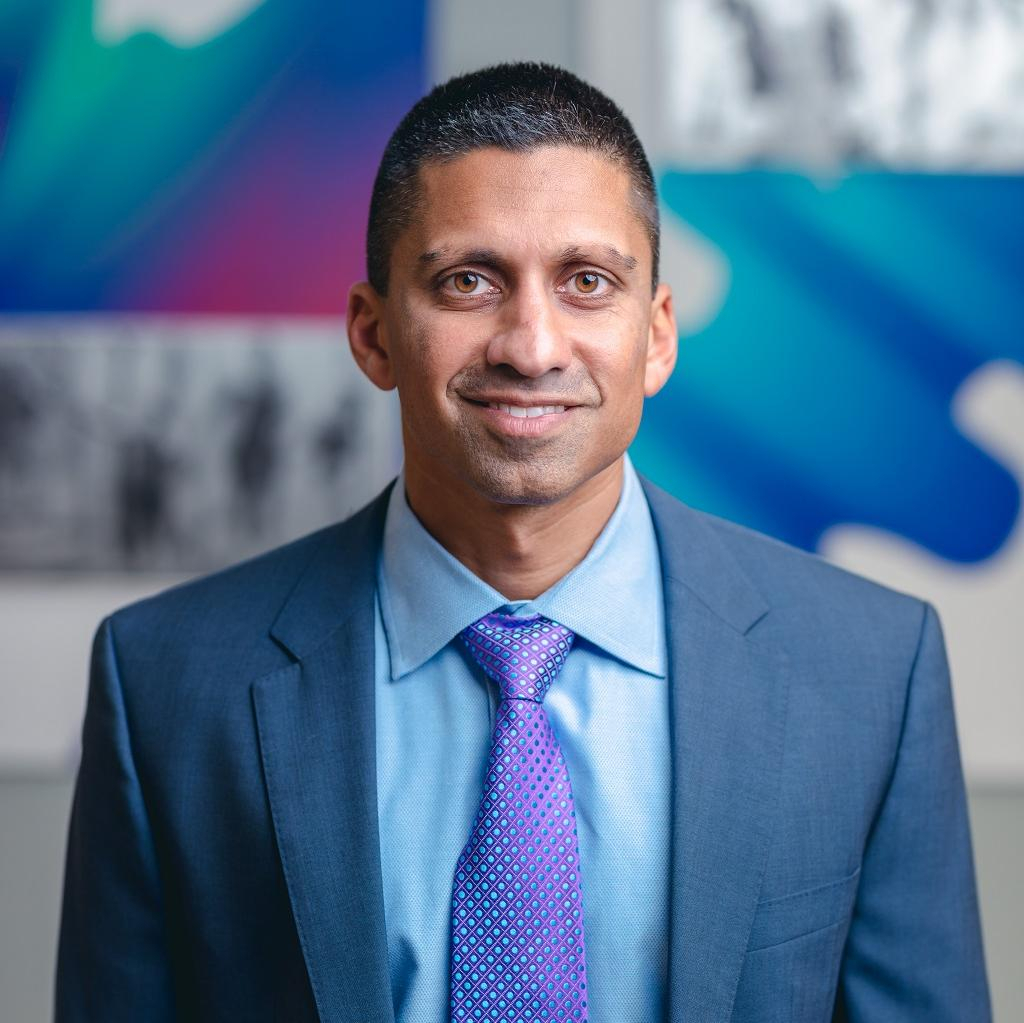 Irfan Asif, M.D.
Irfan Asif, M.D.
Q. What are some of your most important goals when you look at primary care at UAB and in Alabama?
A. I want to reach out across the state, particularly when it comes to connecting with primary care practices, and help them improve care for the patients they serve. Additionally, I would love to educate future generations of family medicine physicians with their help. I want to find ways to work together to recruit more primary care physicians to our state, a critical area of need for Alabama. These are big goals, with big challenges, that require as many people as possible to work together.
Q. What are some of the biggest challenges primary care providers are facing in Alabama?
A. Broadly, preventative medicine is not where it should be, which of course leads to more disease. There is also a significant shortage of primary care physicians in Alabama. A study from the Robert Graham Center projects that Alabama will need 612 new primary care physicians by 2030 just to maintain the status quo. Some of the shortage stems from an increase in demand, as providers care for an aging population with high rates of chronic disease. Some of it is a supply issue, as many physicians are either retiring or becoming burnt out as they need to care for more and more patients.
As a state, Alabama also ranks among the worst in the U.S. in rates of diabetes, heart disease and chronic diseases, and in issues like mental health care. We are focused on designing community programs around those concerns, whether that is our Exercise Is Medicine partnership with the YMCA, which helps patients work toward a healthier lifestyle, or our genomics program, which helps us predict who is most at risk so that we can intervene.
Q. Looking back at 2021, what were some exciting developments you saw in primary care at UAB?
A. There is a lot to be proud of. We have increased the number of patients that we are seeing and the number of ways that we are meeting patient needs. This effort has been led by our new department Vice Chair of Clinical Affairs, Erin Delaney, M.D. Tied to this, we are incorporating many of our research efforts into our clinical services. This includes a unique genomics program that has begun to identify the diseases people are at risk for, as well as the medications that might be most effective for treating a particular disease.
Finally, we are expanding our educational offerings through our Comprehensive Urban Underserved and Rural Experience (CU2RE) program. CU2RE is incredibly exciting, as it doubled its student intake this year, received $5.2 million in HRSA supplemental funding and is helping us build partnerships across the state. We are also continuing to build partnerships in the community, whether through the Exercise Is Medicine program with the YMCA or participation with great organizations like Be a Blessing Birmingham.
Q. Looking ahead, what does success look like to you?
A. A big metric is increasing the number of students who go into primary care, including family medicine, internal medicine and pediatric care. We will continue building collaborations with those departments and with all four UAB campuses.
Increased research funding in the department is another important measure of success, as we continue to find ways to deliver better patient care through research. I also hope to continue to bring more and more people together in health care teams – physicians, but also pharmacists, dieticians, social workers, psychologists and others – and teach students to work well within those care teams. Another important question is how we can use innovative models, such as telemedicine, to increase patient access.
Of course, the most important measure is changing health outcomes. Our work is designed to reduce poor health outcomes in the state and help more and more patients live healthier lives, and that is the ultimate measure of success.
Q. Part of your role focuses on rural health. What are some challenges and opportunities in rural health care in particular?
A. Disparities exist in many areas, but there are certainly disparities in rural health care. In Alabama, shortages are most acute in rural areas, exacerbated by hospital closures and a lack of physician access.
We are working to address these concerns in several different ways. For example, we received a $5 million grant in October from the Center for Medicare and Medicaid Services’ Community Health and Rural Transformation Model, or CHART, to improve access to quality care in rural communities and increase the use of value-based care models, which incentivize disease prevention strategies.
We are also focused on recruiting providers to rural areas, through programs like CU2RE and partnerships with Alabama Health Area Education Centers (AHEC). We want to build and strengthen mechanisms to attract students from rural areas and train students in rural areas, with the hope that one day they will practice in those areas.
Q. On a personal note, what do you enjoy about this work? What keeps you motivated?
A. I like working with people, I like making an impact and I like the challenge of building programs and, hopefully, seeing them grow and be successful. Those are the things that drive me. I also appreciate that UAB as an institution has been very supportive in our mission to improve primary care, allowing us to grow as a department and in our primary care services. Being in an environment that fosters growth and development in primary care has been very enjoyable.
Personally, I also believe strongly that daily lifestyle adjustments and physical activity can help people reach their health goals and, sometimes, prevent the need for a lot of medication or intervention. Patients come into our clinic, of course, but that is only a small snippet of their lives. It is what they do outside of our clinic – the health choices that they make every day – that really affects their overall health. If we can help them make healthy choices in their daily lives, that is the best way to support long-term change. That is the mindset that I bring to my work and that I enjoy.
Expanding Our Reach: CU2RE Continues to Improve Primary Care Pipeline
Now in its second year, the Comprehensive Urban Underserved and Rural Experience, or CU2RE, program has expanded rapidly, earning $5.2 million in supplemental funding and attracting a growing number of students committed to serving the people of Alabama through primary care.
The CU2RE program welcomed its second cohort at the end of 2021, accepting 16 MS1 students. They join an inaugural cohort of eight MS2 students who began the program in 2020 after the department was awarded a $7 million grant from the Health Resources and Services Administration. Supported by the grant, CU2RE aims to enhance the recruitment, training and retention of medical students dedicated to serving urban underserved and rural populations through family medicine and primary care.
While the first cohort focused on the Urban Underserved Pathway, or U2P, emphasizing primary care and health equity in urban areas, the second cohort also welcomed students to a new Rural Pathway, which will emphasize primary care in rural areas of the state, providing hands-on experience and training in the unique challenges facing rural patient populations.
As this pathway expands placement of students around the state, the $5.2 million in supplemental funding, awarded by HRSA in August, is providing resources to support them. The funding is being used to increase educational activities for medical students, redesign the family medicine clerkship curriculum across all UAB regional campuses, provide CU2RE students with stipends to offset medical education costs and implement new faculty, staff and student development initiatives.
To allocate the funding, Irfan Asif, M.D., department chair and associate dean for primary care and rural health, asked campuses and family medicine residency programs throughout the state, including those in Huntsville, Tuscaloosa, Montgomery and Selma, to submit requests for resources needed to fulfill the goals of the HRSA grant. CU2RE leaders went through every request and, working within the parameters of the HRSA grant, allocated funding for several new initiatives aimed at increasing the number of students who will enter family medicine and primary care. These include:
- Pipeline programming designed to support the Huntsville Pre-Medical Internship for college students interested in rural medicine, create a new Tuscaloosa Pre-Medical Internship, and create an Early Assurance Program with Alabama A&M and Oakwood University, allowing students to obtain resources for MCAT preparation and registration.
- Simulation training labs and equipment, which will give students the space and equipment needed to practice skills they will use every day as a physician.
- Point-of-care ultrasound (POCUS) technology and training, allowing family medicine and primary care physicians to use ultrasound technology in-clinic, reducing costs and improving access for patients while allowing for rapid, real-time care.
- Faculty development courses for point-of-care ultrasound, simulation and courses with the Society of Teachers of Family Medicine.
- Housing, transportation, materials and equipment support for the Huntsville Rural Pre-Medical Internship
- Scholarship and stipend support for Integrated Residency and CU2RE students
With those allocations, the HRSA supplemental funding will provide tangible support to both students and faculty and expand the CU2RE program’s reach around Alabama
“In many ways, the supplemental funding has allowed us to accelerate some of the work that I originally saw as 3-5 years away in the CU2RE program,” Asif said. “Growing the program from eight to 16 students is fantastic and that growth, along with the resources from the supplemental funding, is giving us many opportunities for collaboration around the state.”
What’s Next
As part of the work related to the new supplemental funding, the department will assemble a task force of leaders from all Heersink School of Medicine campuses to create new clerkship objectives, experiences, and educational offerings. This group will form the Family Medicine Clerkship Redesign Task Force. The task force will focus on implementing educational curricula for medical students related to POCUS, simulation training, gamification of family medicine educational content and more.
“We have invited people from around the state to come together to think about curriculum design, faculty development and how we want to teach our curriculum,” Asif said. “That is really the next phase of the use of this funding.”
More broadly, leaders also hope to continue to expand the CU2RE program’s reach by developing partnerships throughout the state and building up pipeline programs, designed for high school and college students interested in primary care and health equity, with a passion for serving underserved communities.
Building a Pipeline
Pipeline programs, designed to educate and encourage students to pursue a career in medicine, are a major part of the CU2RE program and the department’s goals. During the 2020-21 academic year, the department participated in several pipeline programs aimed at high school and college students, including:
The UAB Heersink School of Medicine Virtual Immersion Pre-Med Program: The department provided curriculum content for the VIPMed program, which connects pre-med students, particularly those from underrepresented populations, to UAB medical education leaders, hands-on training and other resources.
The UAB Summer Health Professions Education Program (SHPEP): CU2RE students participated in a session of the summer 2021 program, discussing the medical school application process and answering questions from undergraduate students. Assistant professor Sameera Davuluri, M.D., medical director of UAB Family and Community Medicine – Hoover, also participated in a longitudinal case study during the program.
These programs helped to introduce more than 60 undergraduate and pre-medical students to the UAB Heersink School of Medicine, previewed topics, including health disparities, that students will focus on in medical school, and provided resources for the application process.
Considering Brain Health: A Perspective on Learning More About Personal Wellness
The Department of Family and Community Medicine’s UAB Hospital-Highlands and Hoover clinics are starting a partnership with the UAB Evelyn F. McKnight Brain Institute to help patients better understand how lifestyle decisions affect brain health. The Brain Health Initiative will work with participants to prevent cognitive decline and work toward healthier habits. Our communications team was asked to help share about the new program and encourage the community to get involved.
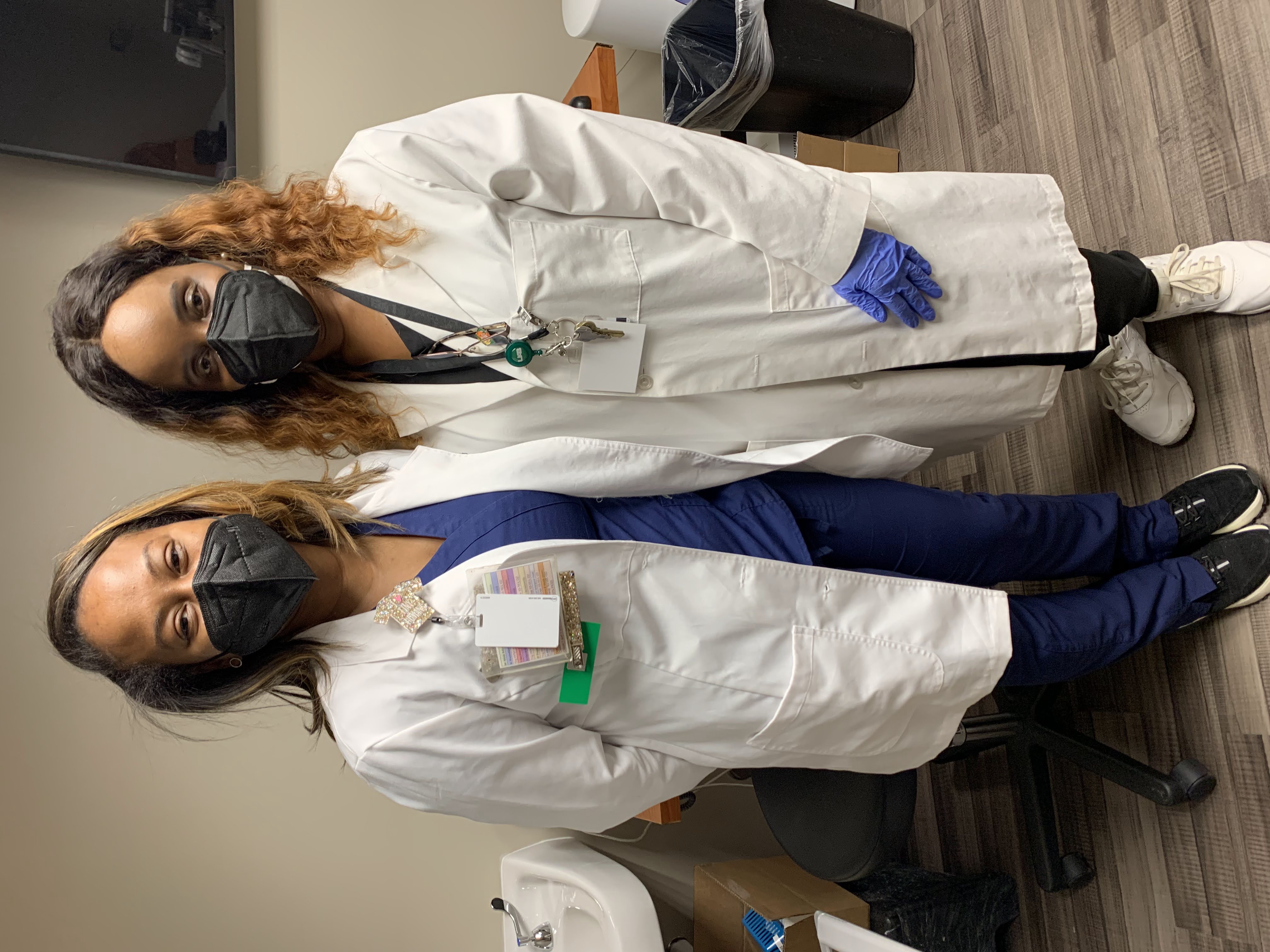 Program team members Tiffany English, R.N., and Pamela Bowen, Ph.D.
Program team members Tiffany English, R.N., and Pamela Bowen, Ph.D.
Since I came to work at the UAB Heersink School of Medicine, I have learned a lot about working toward a healthier lifestyle from the family medicine providers I interact with on a daily basis. They care about helping patients when they are sick, but they also care about preventing illness and improving quality of life. I know that my habits of drinking more water, walking 30 minutes a day and being more aware of the foods I eat (or don’t eat) are a direct result of their advice and care.
As a communicator in health care, it can be challenging to put yourself in a patient’s shoes. Some of the folks we talk to are facing incredibly difficult situations or the worst parts of their health care journeys. It is important to keep in mind what they are experiencing and what the process is like for them. When we heard about the new brain health program, it seemed like a great opportunity to experience and share the patient side of the story.
The program, led by Principal Investigator Ronald Lazar, Ph.D., professor and the Evelyn F. McKnight endowed chair for learning and memory in aging in the Department of Neurology and director of the Evelyn F. McKnight Brain Institute, is open to any UAB patient who was 18 years old, generally healthy and staying in Birmingham for at least a year. I was a little shocked that I fell into the criteria – I don’t think about brain health much as a young, fairly healthy person – but I decided to give it a try and see what I could learn so that we could share the experience with potential patients.
The program centers around the idea that brain health and cognition can be maintained and improved before an issue or diagnosis arises by introducing a primary care agenda for brain health. Providers hope to encourage and introduce healthy habits such as getting regular exercise, eating a healthy diet and other lifestyle improvements and to remind patients that our brains need regular care and “maintenance measures” just like our heart or lungs.
Here’s how it works.
Arrival and Intake
Because I am already a patient with the Department of Family and Community Medicine, my provider was able to quickly refer me to participate in the program. Any current patient with UAB family medicine who meets the criteria can be referred to the program at no cost.
When I arrived at the clinic to begin the process, I was greeted by Pamela Bowen, Ph.D., CRNP, FNP-BC, BBA, associate professor in the UAB School of Nursing and scientist for the Evelyn K. McKnight Brain Institute, and Tiffany English, a UAB nurse practitioner student.
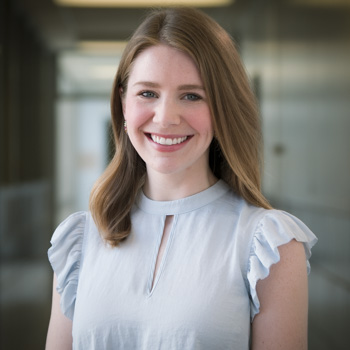 Erin Slay-Wilson, M.A.
Erin Slay-Wilson, M.A.
The initial intake lasted about 30 minutes and included questions about my health background, any current issues I was facing and a finger prick to record my cholesterol and glucose levels. I was also weighed and had my blood pressure taken, but many patients will not have to do this if they’ve had an in-person visit within the last year.
When asked about the process of the program, Lazar said the Highlands clinic provided a good platform for the collaborative pilot program.
“This is a pilot study, which means we would like to evaluate this small-scale preliminary program to evaluate the logistics, time, needed resources, challenges, and strengths of the program to improve upon the design of the program before launching a larger project,” said Lazar.
The program team hopes to learn throughout the first year and talk with participants to find out what works and what can be improved, all in hopes of improving the way that individuals see their role in maintaining and promoting brain health.
“The brain is the part of the body that defines us as human, with the ability to function effectively in our everyday world,” noted Lazar. “As we age, there is some decline that is normal, but if left unchecked, then there is little we can do. Most cases of cognitive decline and dementia, however, can be delayed and even prevented if we take charge of how we take care of ourselves. We would like for participants to value and incorporate health promotion strategies into their daily lives.”
Goal Setting
After they collected all of my information, the team calculated what they call a “Brain Care Score,” an estimate of the general health and wellbeing of a person’s brain. Based on this score, they asked me what specific areas I would like to work on to improve my overall health. The team went through ideas like increasing exercise during the week, replacing sugary drinks with more water to control blood sugar levels and getting more sleep.
"Research suggests convincingly that risk factor reduction, such as reducing high blood pressure, and adopting healthy lifestyle behaviors, such as exercise, can decrease the likelihood of cognitive decline,” said Lazar. “This program provides an individualized approach to health promotion. After calculation of the Brain Care Score to determine which risk factors need to be addressed, we allow the participant to take charge of their own well-being by indicating which areas of their health is/are a priority to them.”
I chose to work on improving my anxiety levels by being more regular with journaling (3-5 times per week), getting more rest by beginning my nighttime routine by 10 p.m. each night (and avoiding screens after this time) and engaging with physical activity more regularly by adding 10 reps of weights to my walking routine. (The nurse was kind enough to show me several ways of getting my reps in.)
Follow-Up
The program team will call me in six months to check in and see how I am doing with my goals. There is another research group that will have more frequent calls. They want to measure whether personal choice and supportive accountability can elicit change more quickly or build habit more effectively in patients at all levels of health. Because primary care focuses on prevention and incorporating lifestyle changes to improve health, the program team is excited to work within a primary care setting to learn more about this program’s potential.
“The implications are that working toward better health is a lifelong endeavor, and primary care is the ideal setting to promote this goal,” said Lazar.
The program is open to 100 participants. Talk with your UAB family medicine physician if you are interested in joining the program and working toward a healthier brain and a healthier you.
Five Questions About Women’s Health During Women’s History Month
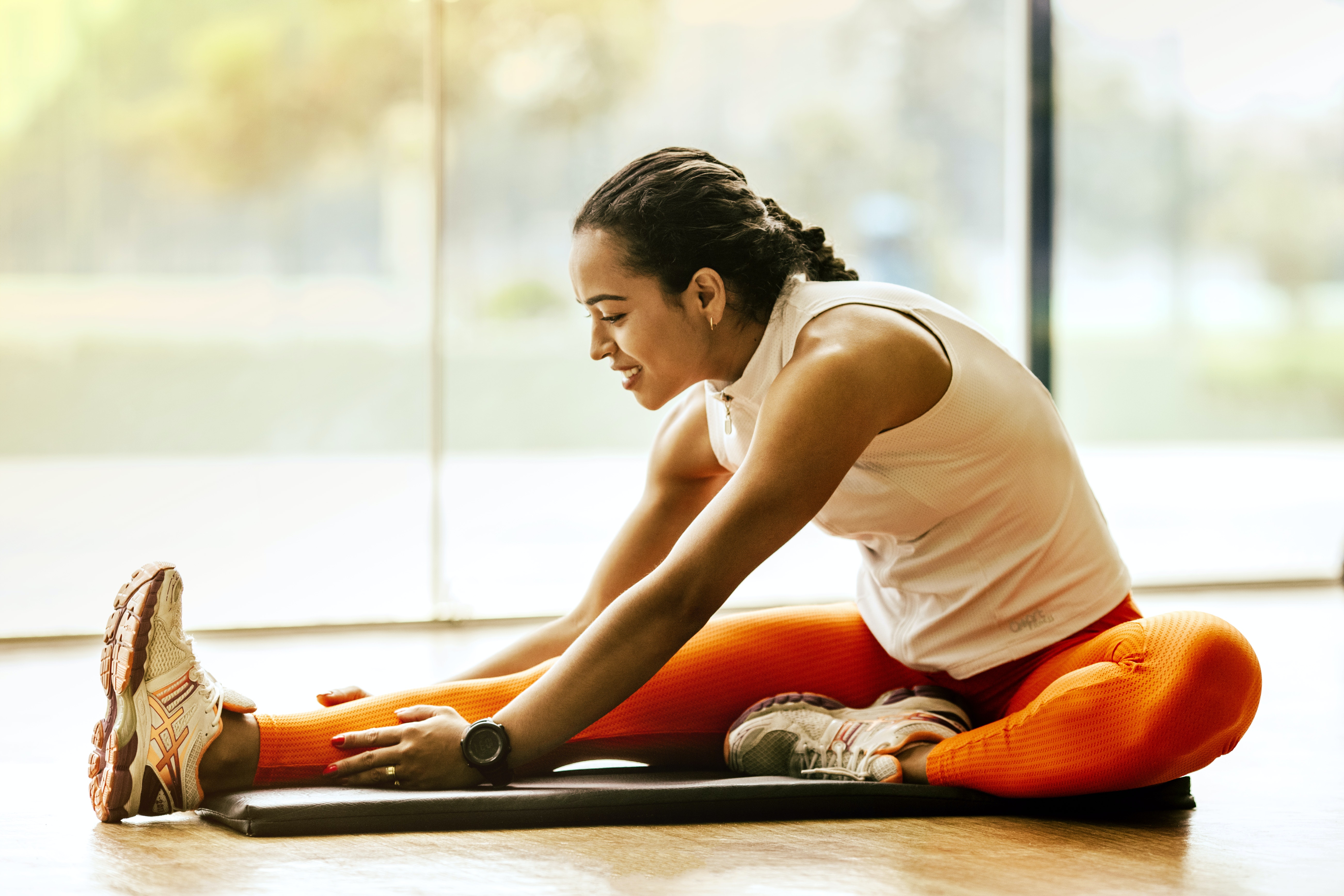
March, celebrated as Women’s History Month, offers us another chance to reflect on women’s health needs and concerns.
UAB Department of Family and Community Medicine providers take pride in addressing these unique needs with personalized care for female patients, including everything from important preventative screenings to advice for conception, pregnancy or infertility. While this has always been a part of the care our providers offer, the department is currently expanding and formalizing its women’s health program, making it easier than ever for female patients to access care.
We spoke with two providers, Erin DeLaney, M.D., assistant professor, vice chair of clinical affairs and quality and medical director of UAB Family and Community Medicine – Highlands, and Sumayah Abed, M.D., assistant professor and clinician at the Hoover Family Medicine clinic, to learn more about women’s health offerings within family medicine.
Q. What are the most important screenings female patients should discuss with their provider?
DeLaney and Abed: Female patients should talk with their provider about the following critically important screenings:
- Cervical cancer screenings with pap smears starting at age 21 and then every three to five years based on age and risk factors
- Breast cancer screening with mammograms starting as early as age 40 for some women
- Sexually transmitted disease (STD) screening for those who are sexually active and higher risk
- Osteoporosis screening with bone density studies starting at age 65 or younger for some women depending on risk factors
- Skin cancer, hypertension and depression screenings for all women, regardless of age.
Q. What are some other questions women should be discussing with their primary care providers?
DeLaney: Important topics to raise include nutrition, exercise habits, sleep habits, questions about supplements or vitamins, cancer screenings, preventative immunizations (particularly Gardasil, the HPV vaccine) and preconception counseling for women preparing to have children.
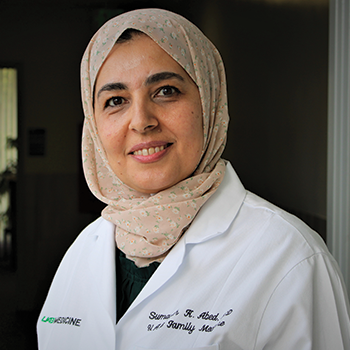 Sumayah Abed, M.D.
Sumayah Abed, M.D.
Abed: Besides screening and contraception, family medicine physicians manage many other women’s health-related illnesses, such as PCOS (polycystic ovary syndrome), infertility, vaginitis, STIs (sexually transmitted infections), PID (pelvic inflammatory disease), menstrual and abnormal bleeding disorders, postmenopausal symptoms, preconception health, management of chronic medical diseases during pregnancy and screenings for domestic violence. Patients can bring up concerns about any of these conditions or topics to their family medicine provider.
Q. How has women’s health advanced in recent years to provide a better experience and better outcomes for patients?
DeLaney: Now that we better understand the role HPV plays in cervical cancer, we have been able to offer updated cervical cancer screening recommendations, drastically reducing the number of PAP smears a woman needs in her lifetime. Similarly, changes in breast cancer screening implementation have reduced the number of mammograms a woman may need. The HPV vaccine has also led to a huge reduction in the number of interventions needed for cervical changes.
Abed: In the last few decades there was significant improvement in breast and cervical cancer screening and then decrease in mortality from both cervical and breast cancers. These advances have expanded women’s lifespans. There has also been an increased focus on women’s mental health, as well as decreases in teen pregnancy and smoking rates and rising levels of education for women. Contraception methods have become safer and more easily accessible for women.
There is still room for progress in screening for cervical cancer. Seven percent of women between ages 21-65, which accounts for 8 million American women, have never had a cervical cancer screening with a PAP smear, and more than 11% have had irregular screenings. More than 12,000 American women are diagnosed with cervical cancer each year and more than 4,000 die of it annually. Our goal as family medicine physicians is to reduce deaths from cervical cancer to zero with universal screening that allows for early diagnosis, treatment and care.
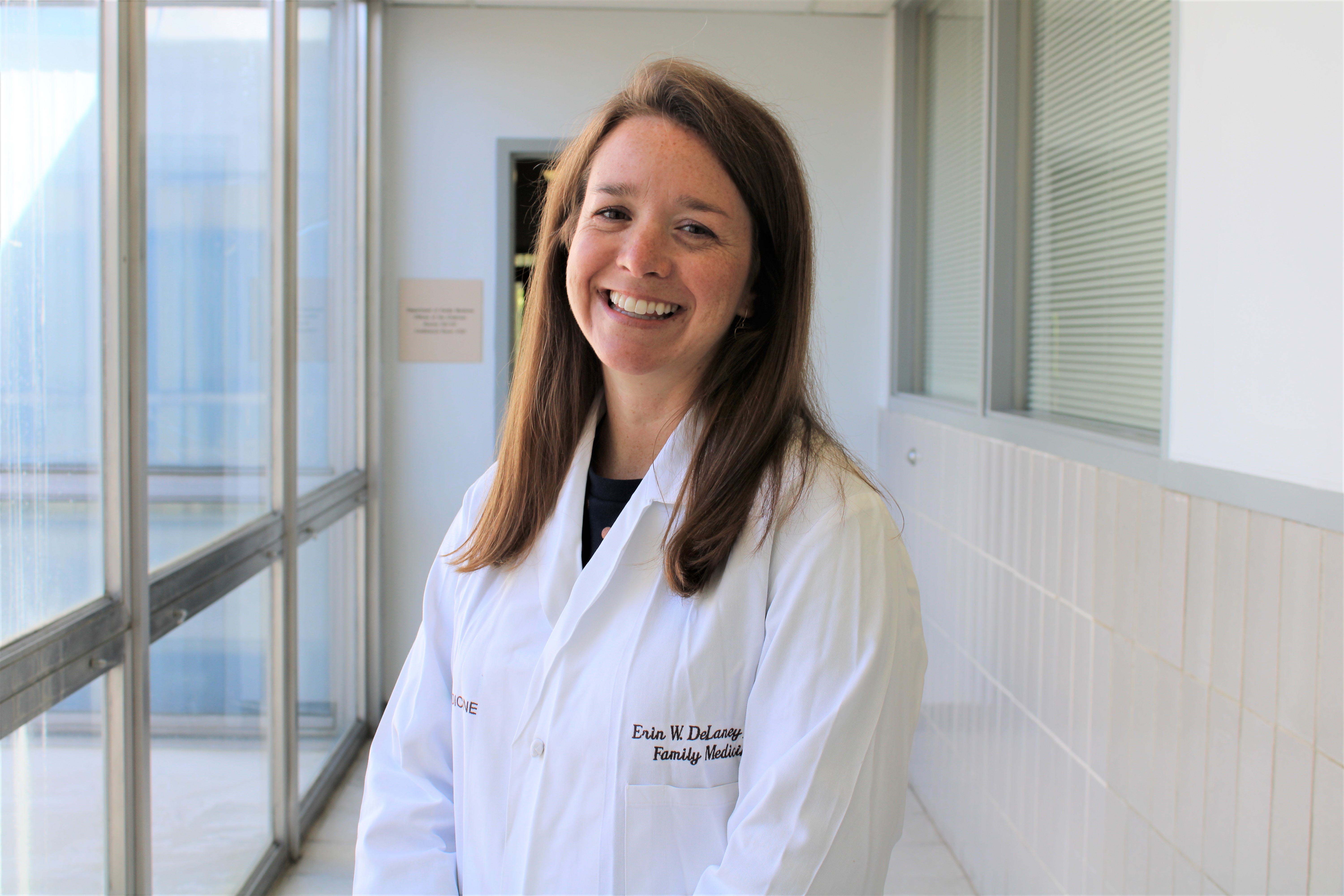
Q. Are there any wellness practices you would suggest particularly for women, or for particular concerns?
DeLaney: Women of child-bearing age should make sure they are getting enough folic acid (from fortified foods or vitamins) and vitamin D (from dairy, green leafy vegetables or vitamins) to help support a healthy pregnancy. As women approach menopause, they should make sure they are getting plenty of calcium and vitamin D to support bone health. For all women, I recommend limiting red meat, eating plenty of vegetables, fruits and whole grains, avoiding sugar-sweetened beverages, choosing low-fat or skim dairy products and limiting eating out.
Abed: Women often take care of their whole family but sometimes forget themselves. I encourage my female patients to take some free time for themselves, often by doing exercise for 30 minutes per day, five times weekly. This helps you stay fit, relaxed and enjoy a good night’s sleep.
Q. How is the Department of Family and Community Medicine expanding and growing women’s health offerings in our clinics?
DeLaney: We have many providers who perform women’s health services and procedures, with a list of services that each provider offers. We are preparing to have a women’s health clinic session so that providers can refer patients to this clinic to be seen in a timelier manner or to have a procedure or counseling done if their regular provider is not able to perform something. We are also preparing to offer our patients pre-natal care in collaboration with UAB Obstetrics and Gynecology. Overall, women can expect to have their needs met with excellent care.
Abed: By establishing a women’s health program, we will deliver comprehensive care for women of all stages of their life, providing gender-specific care and very skilled health management. The female patient should expect to meet a provider who is ready to answer all of her questions and address her concerns.
We are also looking forward to starting hand-on training of medical students in women’s health issues, and to seeing family medicine residents spend more time in women’s health training.
Building Up the Medical Workforce One Student at a Time: AHEC Scholars and COVID-19
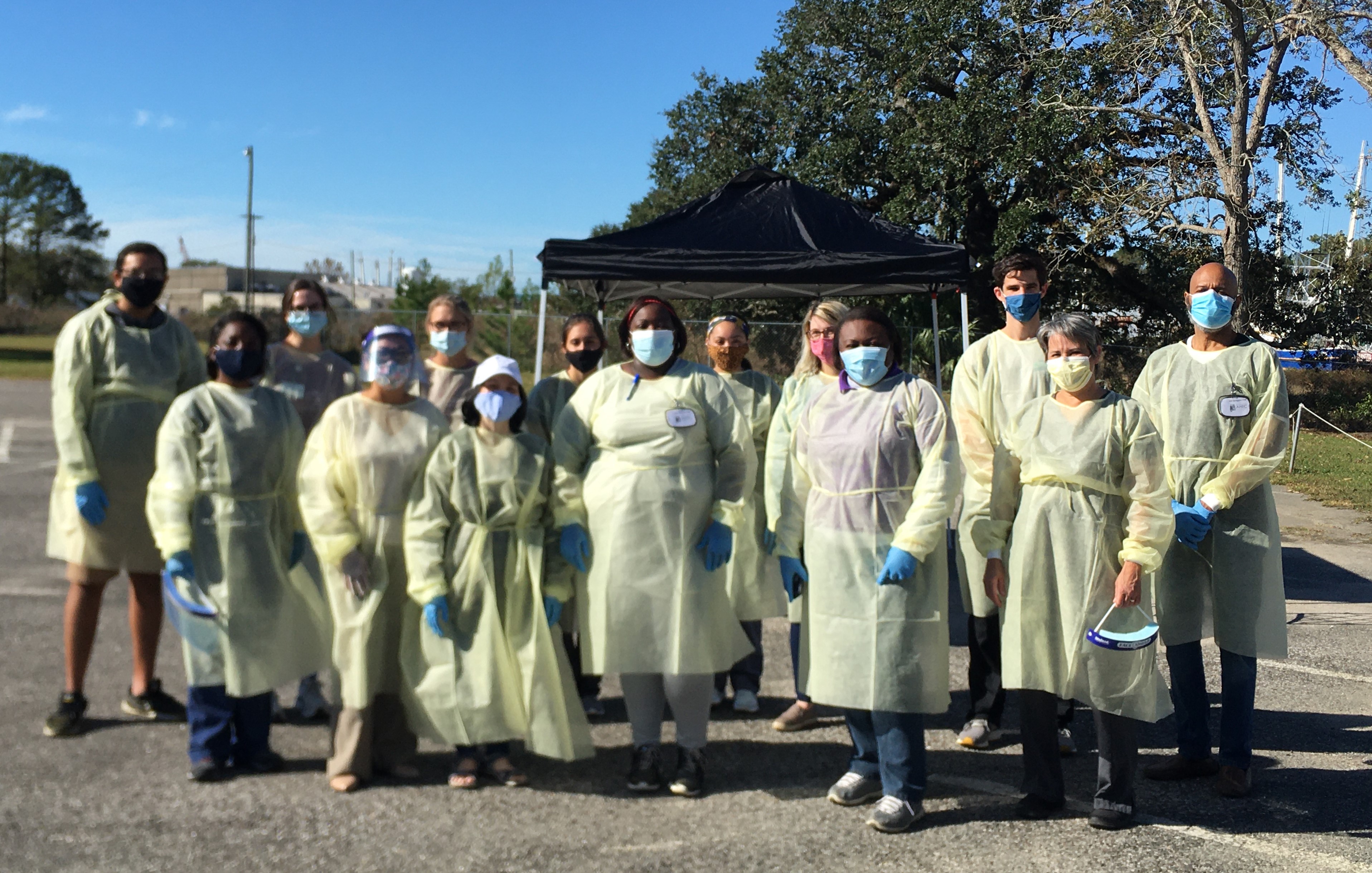
When a hospital or health care center experiences worker shortages, the impact can be far reaching. Shortages impact patient care, put strain on current employees and affect a hospital’s ability to make positive changes as it scrambles to complete daily tasks. The COVID-19 pandemic, including the most recent surge, has put even more pressure on health care systems and exacerbated many situations where shortages were already an issue.
Read moreQ&A: What the Omicron Variant Told Us About Primary Care Gaps in Alabama
Alabama appears to be on the tail end of the omicron COVID-19 surge after case numbers and hospitalizations spiked in January as the contagious variant spread rapidly through the population.
The surge stretched hospital capacity, but it also stretched the capacity of primary care clinics, highlighting some important gaps that need to be addressed as health care leaders plan for the future of primary care in Alabama.
We asked Irfan Asif, M.D., chair of UAB’s Department of Family and Community Medicine, associate dean for primary care and rural health and head of UAB’s primary care service line, about what omicron can teach us about primary care in Alabama. Several programs in the Department of Family and Community Medicine, including the Comprehensive Urban Underserved and Rural Experience program, or CU2RE, aim to increase the number and quality of primary care providers in Alabama, providing more health care coverage in urban and rural underserved areas.
Q. What did the omicron surge tell us about the state of primary care in Alabama?
A. Initially, much of the thought around COVID focused on people who were being hospitalized, which was certainly a terrible problem. Everyone was intent on figuring out how we could help those who were hospitalized and at risk of death, and that remains a concern. However, as the disease mutated into the omicron variant, it became less lethal but infected more individuals. That is when it starts to become a problem for those outside of the hospital. This latest surge really taxed our primary care system, whether it was people visiting their primary care doctor for a milder case, people leaving the hospital or emergency room who need follow-up care, or staff members and providers getting sick. We don’t have enough access to primary care in Alabama, or enough primary care providers, and this surge made that clear.
 Irfan Asif, M.D.
Irfan Asif, M.D.
Q. Which trends worried you the most?
A. Lack of access, especially in rural and urban underserved areas, is a huge concern. On the staff side, burnout is also a big worry. The joy of primary care is being lost because people are working so hard. During this latest surge, so many people were infected that staff were out as well and the system was really taxed because people were working 150% all of the time, on top of this chronic two-year COVID battle.
Q. How can we combat burnout?
A. This is something I think about often. One thing we can do is make sure that burnout is an open part of our conversations. A lot of people do not actively think or talk about burnout. We have to do that. We have to make sure it is ok to use as part of our vocabulary, and that we are openly assessing burnout. UAB has some tools to do that with our faculty and staff, such as a well-being index that helps people self-assess their mental health and discuss it with colleagues and supervisors. We need to have those conversations and, especially as leaders, understand where our people are and what they are facing. We also need ways to build people up. In our department, that might look like the new Kudoboard we just launched (an online board for sharing congratulations, thanks, photos, kudos and other encouragement) or programs like our Wellness Walks, which encourage faculty and staff to take breaks for exercise and time outside. Communication is also critical, because in COVID we are all particularly stuck in our silos – or little Zoom boxes. We need to prioritize reaching out to each other and getting creative, even when circumstances make it more challenging.
Q. What good signs or encouraging trends have you seen even as omicron?
A. Providers and staff came up with some creative solutions using things like telemedicine in ways we had not done in the past, or trying to implement remote patient monitoring. We were able to lean on those techniques more effectively in this most recent surge, as opposed to the first COVID surge where we were still adapting to telemedicine.
However, it is important to remember that telemedicine brings its own concerns, particularly related to health disparities. Not everyone has reliable access to broadband internet, so some patients might have to have phone visits rather than video visits. That could impact the level of care we can provide.
Q. How can we address some of the gaps that omicron exposed?
A. On the workforce development side, we need to figure out how to bring back the joy of primary care so that health care workers are not as burnt out and we can accommodate patients that come in with appropriate access. In my view, that needs to be not just a patient and one provider, but a team of providers – nurses, doctors, advanced practice practitioners, pharmacists, social workers, nutritionists, psychologists, etc. – working together to provide that access. We need to put that team-based structure in place and create an education system that prepares a workforce that will want to go and take these jobs.
I think CU2RE is an important part of that mission, as is the Alabama Statewide Area Health Education Centers (AHEC), housed in our department. These initiatives are working to train students in team-based care and help them to recognize health disparities and identify creative solutions. We have to model those kinds of practice transformation efforts for our students. If they learn an older model of primary care and step into a world that needs a new model, they will not be prepared.
Q. As you consider the future of primary care in Alabama, and a strategic plan for that future at UAB and beyond, how has COVID factored in or shaped your thinking?
A. From a UAB side, this is a massive effort. We are working to focus attention on primary care, and that was true before COVID. However, COVID certainly exacerbated some of the issues we were seeing and added urgency to the situation. I am looking forward to working with health care leaders to build a primary care strategic plan for Alabama. The time is right and we need to get started right away, as bringing our vision to fruition will require considerable time and effort from a lot of people.
Walking Through History: Join Us for a Tour of Birmingham Designed to Spark Discussion
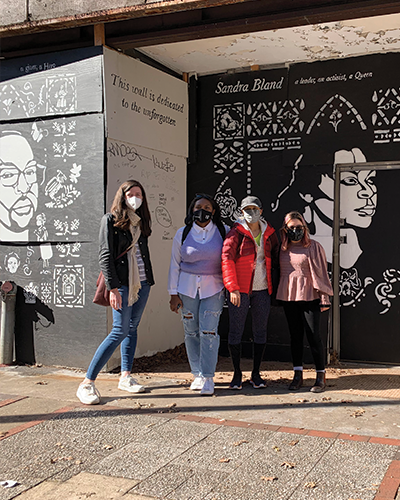
Reading or learning about events in a classroom is important, but it’s hard to substitute physically being in a space, seeing where history has happened and new stories play out every day.
In the summer of 2021, eight UAB medical students in the Department of Family Medicine’s Comprehensive Urban Underserved and Rural Experience, or CU2RE, program joined Brandi Shah, M.D., MPH, and Shyla K. Fields, MBA, for tours of civil rights landmarks and museums in Birmingham and Montgomery.
The CU2RE students took in the history of each space and used the setting as an opportunity to discuss health care disparities, racism in medicine and social determinants of health. Those concepts are foundational to CU2RE’s mission of building a stronger primary care workforce for urban underserved and rural areas of Alabama, and to UAB’s larger mission of practicing compassionate, culturally conscious health care that meets the needs of all Alabamians.
Students at the time called the program “extremely impactful,” according to Channing Bruce, and full of meaningful discussion. CU2RE student Kristina Redd said the program not only grew her understanding of what it means to be a physician, but also “create[d] memories that captured my soul and resonated with me in such a way that affirmed my work and calling as a healer.”
To commemorate Black History Month, three members of the Department of Family and Community Medicine communications team – Caroline Newman, Erin Slay-Wilson and Kenia Hernandez – recreated the Birmingham portion of the tour with Shah and Fields. Below, you can see the stops that they visited, along with reflections from the team.
Anyone wishing to recreate this tour can use publicly available resources created by Shah and Fields, including this map showing every stop. Photos, links and additional resources are available below.
Preparation
The tour began before the team even left the office, as each member did advance research on several of the sites they would be visiting. Shah and Fields also assigned each person an intersectional identity to think about during the tour, prompting discussions of how people of different backgrounds, with different advantages and disadvantages, might think about each site.
Slay-Wilson said she appreciated being able to do research in advance. “It made me feel more connected and engaged with the material and history of each location,” she said.
The intersectional identity exercise added another layer. Each person was given symbolic taxes (privilege) or rebates (resilience) that came with advantages or disadvantages in their identity including, for example, gender, race, access to transportation, health conditions, or socioeconomic status.
“I was a young Black man with a GED, car and criminal record,” said Hernandez. “Being a man and having a car was an advantage but my skin color and background were a disadvantage. The exercise showed us how many opportunities a person could miss because of the color of their skin or their criminal record.”
Landmarks
Follow the links below to learn more about each site visited on the tour.
- The A.G. Gaston Motel
- 16th Street Baptist Church
- Boutwell Auditorium
- Linn Park (confederate monument removal)
- Penny Savings Bank
- Carver Theatre
- Colored Masonic Temple
- Third Avenue Murals
- Negro Southern League Museum
Reflections
At the end of the tour, Hernandez, Slay-Wilson and Newman each took time to reflect. Here are some of their thoughts.
I have lived in Birmingham for more than three years and hadn’t ever visited most of the sites that we toured. The day was filled with plenty of emotions, and I felt like it was a great experience to go on the tour with coworkers I had built relationships with—it felt like we could all have genuine reactions and share our thoughts together authentically. […] The identity exercise was eye-opening and humbling as we each answered questions and reflected on where a person with those identities might be or how they might react to a similar tour or part of history. The entire process was thoughtful and encouraged us to play an active role in the tour and in the world based on what we learned. The tour concluded with us eating lunch together and sharing both reflections and casual conversation. I think that was a special time for me as it provided an opportunity to reflect on what we had just done as well as be grateful for the folks around me that are kindly walking alongside me as I learn and unlearn how to address racism and disparities as they exist in our world. --- Erin Slay-Wilson, communications specialist
I am so glad that I had the opportunity to do this tour alongside my coworkers, led by Shyla and Brandi. The tour combined information about some of Birmingham’s most prominent civil rights landmarks, and the racism and violence witnessed there, with intentional moments highlighting joy, empathy, art and celebration in the city’s African American community, such as reflecting on the arts scene at the Carver Theater, the culture of mutual aid at Boutwell auditorium, or music festivals in some of the parks. I found that combination to be really powerful and an important reminder to appreciate both how someone’s background or identity can complicate their life and how it can enrich it. The intersectional identity activity carried a similar message, asking us to both reckon with the disadvantages unfairly imposed on someone because of their identity and to celebrate their unique perspective and contributions. -- Caroline Newman, communications director
This tour was eye-opening, I learned so much about the history of Birmingham. I had no idea that many civil rights activists would meet in the AG Gaston Motel and that it still exists. I learned that many of these locations were a part of “Project C”, a desegregation campaign by Fred Shuttlesworth. […] As I compare my native intersectional identity with my imaginary intersectional identity, I realize that we both have privileges and disadvantages. Both my imaginary and native identity can live wherever, worship whoever, and can be with people like me. I realize that my imaginary identity can have trouble finding preferred hair products and my native identity can have trouble finding preferred foods and music. My imaginary identity and native identity are not portrayed positively on television, movies, songs or in the media especially in these past four years. Slavery is a big part of our history, as well as the Civil Rights Movement and war on drugs but these instances are not positive for Black people. As for the history of Mexican people in the United States, it is overlooked and not positive. This was a great exercise because I realize that even though my imaginary identity and native identity is not the same there are similar struggles. -- Kenia Hernandez, communications intern
Further Resources
Map: https://www.google.com/maps/d/u/0/edit?mid=1q0pVQzGSserVHcoLAZaWmsQcCHPtGgnn&usp=sharing
Foundational article (and reflection exercises) by Peggy McIntosh on the invisible backpack framework adapted for the Flipped Privilege/Resilience Intersectionality activity.
Post-activity reflection in which you compare your native intersectional identity (who you are in real life) with the imaginary intersectional identity that you inhabited during the activity.
Q&A: In Heart Month, 6 Questions About Cardiac Health During Exercise, Including Post-COVID

February is American Heart Month, and it’s a good time to revisit an important question: How can you take care of your heart while exercising or playing sports?
UAB Sports & Exercise Medicine – a partnership between the Departments of Family and Community Medicine, Orthopaedics and Physical Medicine and Rehabilitation – operates a Sports Medicine Cardiology Clinic for Young Athletes at UAB Hospital-Highlands and helps athletes of all ages maximize their performance and stay safe and healthy while competing.
Irfan Asif, M.D., professor, chair of the Department of Family and Community Medicine, associate dean for primary care and rural health and director of UAB’s primary care service line, offered tips for maintaining cardiac health while exercising and playing sports. Asif specializes in sports and exercise medicine and particularly in sports cardiology.
Q. First, how can regular exercise help your heart?
A. Regular exercise has many benefits, including building muscle endurance and strength. Your heart is a muscle, so regular exercise strengthens that muscle. There is also an inverse relationship between regular exercise and heart disease. This includes a beneficial effect of lowering bad cholesterol (LDL) and raising good cholesterol (HDL). Regular exercise also lowers inflammation in your body and reduces blood pressure, both of which have protective benefits for the heart.
Q. What are some of the most common cardiac concerns that athletes of all levels can face?
A. If you are younger than 35, your chance of having heart problems is much lower than those over 35 or over 50. However, there are some conditions that can affect younger individuals. About one in 300 individuals might have an underlying condition and not realize it. Some of those conditions include hypertrophic cardiomyopathy, which is an enlarged heart, Wolff-Parkinson White Syndrome, which is an electrical problem, and arrhythmogenic right ventricular cardiomyopathy, where fat might infiltrate your heart. Those are all conditions that you can be born with and would typically show up before age 35. We don’t yet know the exact mechanism that triggers problems with those conditions – if exercising at high intensity causes a little problem to become a big problem, or if there is another factor, such as not getting enough oxygen. We are still learning about that. Irfan Asif, M.D.
Irfan Asif, M.D.
Individuals over 35, and especially over age 50, are at higher risk of coronary artery disease. Blockages in your heart often occur due to buildup in the arteries that occurs over time. That buildup might get worse with diabetes, high blood pressure or smoking.
Q. What are some simple best practices to keep in mind for exercise?
A. Regular exercise is important. Getting 150 minutes per week is a good goal, balancing between endurance training, such as running, biking or walking, and strength training to build muscle.
One study, in the Journal of the American Medical Association, showed that increasing moderate-to-vigorous physical activity by 10, 20 or 30 minutes per day was associated with a 6.9%, 13.0% and 16.9% decrease in the number of deaths per year, respectively, in the adult U.S. population. Adding 10 minutes per day of physical activity resulted in an estimated 111, 174 fewer preventable deaths per year, with greater benefits associated with the addition of more physical activity.
Q. Are there any warning signs that people should look for before, during or after exercise?
A. If you are exercising and you feel light-headed, short of breath or you get chest pain more than what you might experience normally, that is a cause for concern. Shortness of breath can be tough to quantify, but if you are getting unexpectedly short of breath, are in more pain than usual or if you pass out, you should go straight to a medical provider to be checked out.
Q. If you already know that you have a heart condition, are there certain types of exercise you should pursue or avoid?
A. It depends on the condition, so you would want to work with your doctor to figure out which forms of exercise are best for you. Your health care provider might do certain tests to determine which exercises are safe for you or which heart rate zones you might need to stay within, but the specifics are dependent on the type of disease.
Q. We have heard a lot about heart conditions associated with COVID-19. What should athletes keep in mind if they have had COVID?
A. We are seeing that most people who had COVID but had no symptoms or mild symptoms tend to do OK afterwards and not face cardiac issues. Those with more moderate or severe symptoms should have their heart checked out by a doctor, particularly before athletic activity. I would consider an EKG (electrocardiography) test at minimum, and additional testing depending on the case, to make sure the heart is functioning well.
Most often with COVID, we have seen myocarditis, or inflammation of the heart, after infection. In addition to COVID, myocarditis can occur after other viral infections, such as influenza, and can lead to heart trouble. The risk is highest in the short-term aftermath of an infection and diminishes over time.
I was part of the team that developed cardiopulmonary guidelines for high school student-athletes during the pandemic, published by the National Federation of State High School Associations. Among other things, we recommended that athletes with moderate symptoms, including a fever greater than 100.4 degrees, chills, flu-like symptoms for two or more days, or initial cardiopulmonary symptoms such as chest pain of palpitations, should be evaluated by a clinician. Cardiac testing is recommended for any athletes with cardiopulmonary symptoms during the acute phase of infection. Carefully screening for those symptoms and conducting tests as needed can help get athletes back into competition safely.
Experiencing UAB from the Other Side: Crystal Odom's Family Story
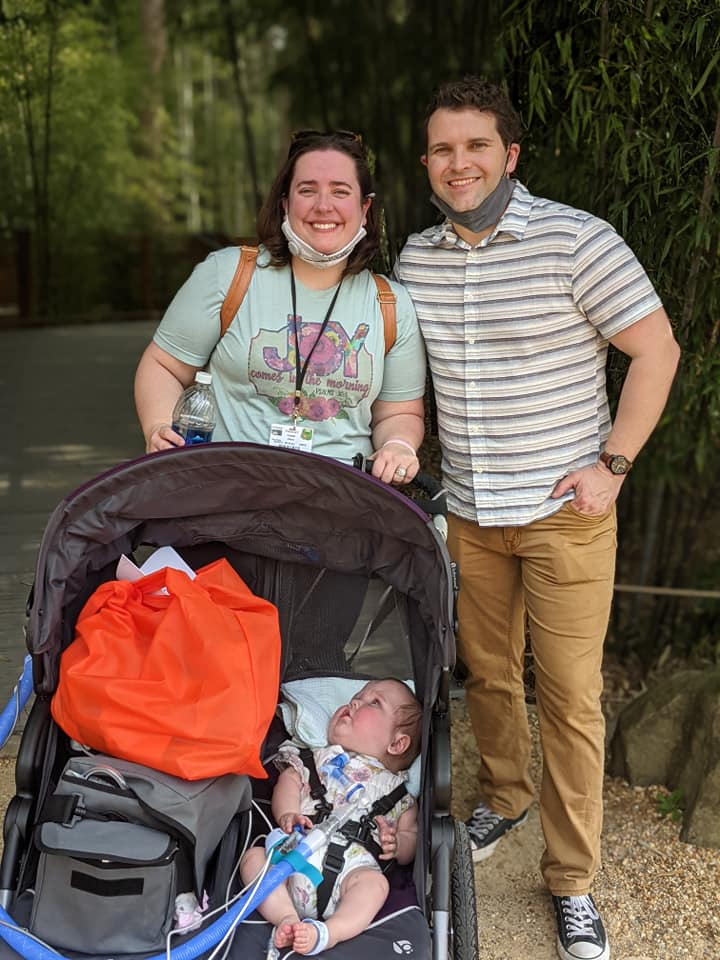 Crystal and Alex Odom with daughter Everleigh (photos provided by the Odom family)
Crystal and Alex Odom with daughter Everleigh (photos provided by the Odom family)
Written by: Kenia Hernandez
At 17 weeks pregnant, Crystal Odom and her family were packing to leave for Thanksgiving to Savannah, Georgia when she felt an intense amount of pressure and had to be rushed to UAB for an emergency cerclage due to an incompetent cervix, a condition that causes the cervix opens too soon during pregnancy.
Read morePandemic Lessons Fuel Department Educators: Leadership at the 2022 STFM Conference on Medical Education
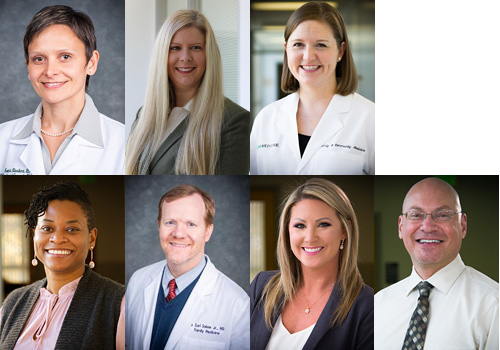 (Top: Ksneia Blinnikova, M.D., MPH, Kala Dixon, Ph.D., Jill Marsh, M.D., Bottom: Adrienne Fowler Payne, Earl Salser, M.D., Kimberly Smith, Ph.D., MIchael Wiederman, Ph.D.)
(Top: Ksneia Blinnikova, M.D., MPH, Kala Dixon, Ph.D., Jill Marsh, M.D., Bottom: Adrienne Fowler Payne, Earl Salser, M.D., Kimberly Smith, Ph.D., MIchael Wiederman, Ph.D.)
Though the pandemic brought many challenges to educators, virtual learning, virtual collaborating and the strain of a world crisis also created opportunities for faculty and staff members in the Department of Family and Community Medicine to focus on ways they could impact their students despite the distance.
Read morePrioritizing a Team: How the Hoover Family and Community Medicine Clinic Achieves Its Goals Together
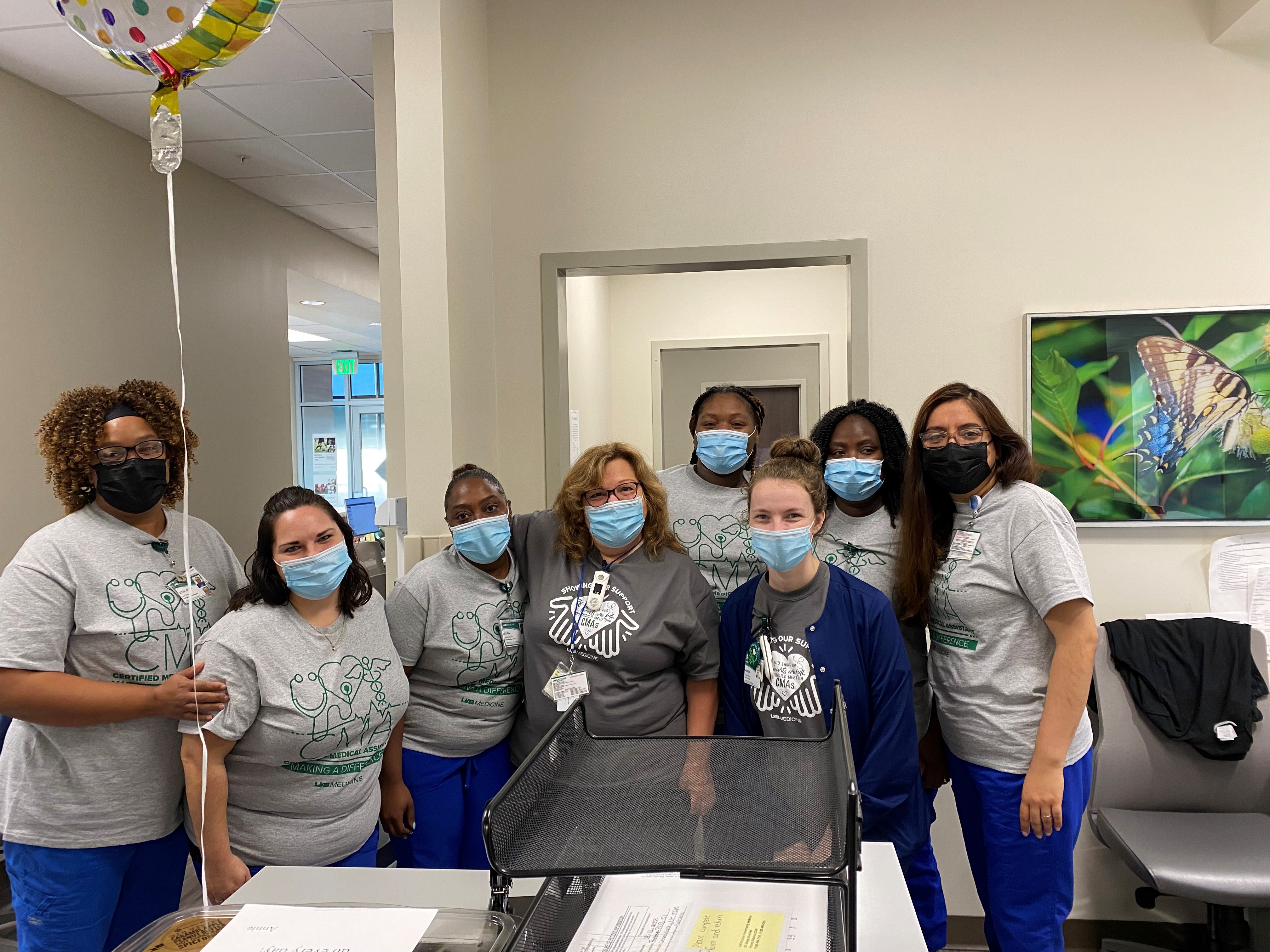 Hoover clinic team members
Hoover clinic team members
The UAB Hoover Family and Community Medicine Clinic, led by Sameera Davuluri, M.D., assistant professor and medical director, and Annie Shedlarski, R.N., nurse manager, consistently ranks among the best UAB outpatient clinics across the health system. Shedlarski knows why.
Read moreProject ECHO Depression Kicks Off 2022 Talks: “Suicide Prevention: Talk Saves Lives”
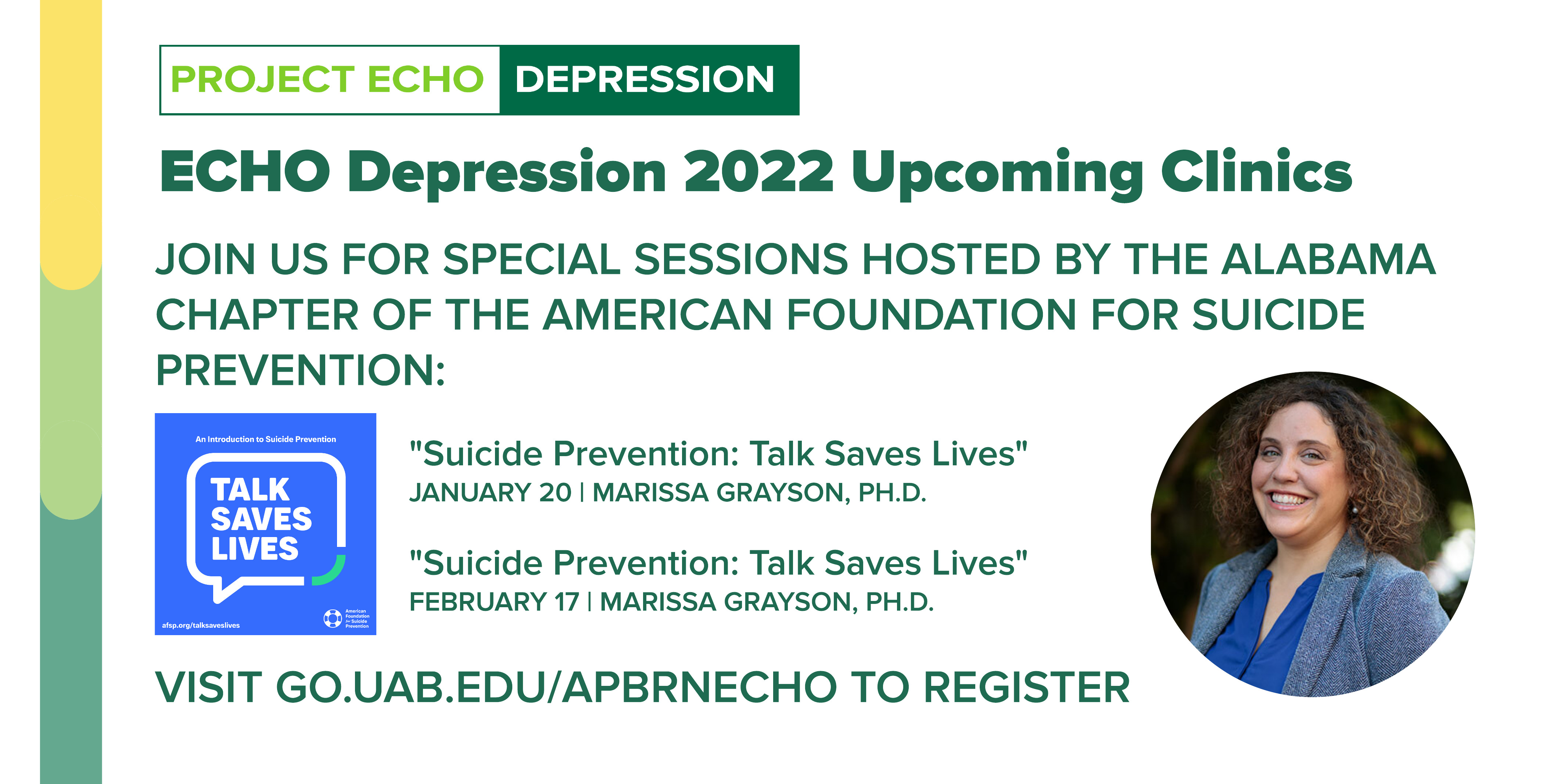
Project ECHO Depression, a partnership between the UAB Department of Family and Community Medicine, the Department of Psychiatry and the Depression and Suicide Prevention Center, is hosting a two-part virtual presentation on suicide prevention to kick off its Spring 2022 series.
Marissa Grayson, Ph.D., of the Alabama chapter of the American Foundation for Suicide Prevention, will speak at both events, the first on Thursday, Jan. 20 at noon and the second on Thursday, Feb. 17 at noon. The talks are open to any interested health care provider or worker. You can register here to attend.
Each talk will also include the case-based discussion that is part of every Project ECHO session. The Project ECHO model is designed to connect family medicine and primary care practitioners across Alabama with teams of experts to help them better care for patients suffering from depression.
The project uses virtual tools to “move knowledge instead of people” and encourages open discussion about difficult cases to help health care teams provide even better care.
Participating physicians receive access to virtual monthly clinics, staffed by UAB psychiatrists, a family medicine physician, psychologists and patient advocates.
Find out more about Project ECHO Depression and see the full schedule of spring semester talks here.
CU2RE Program Nearly Triples in Size, Aiming to Address Primary Care Shortages in Alabama
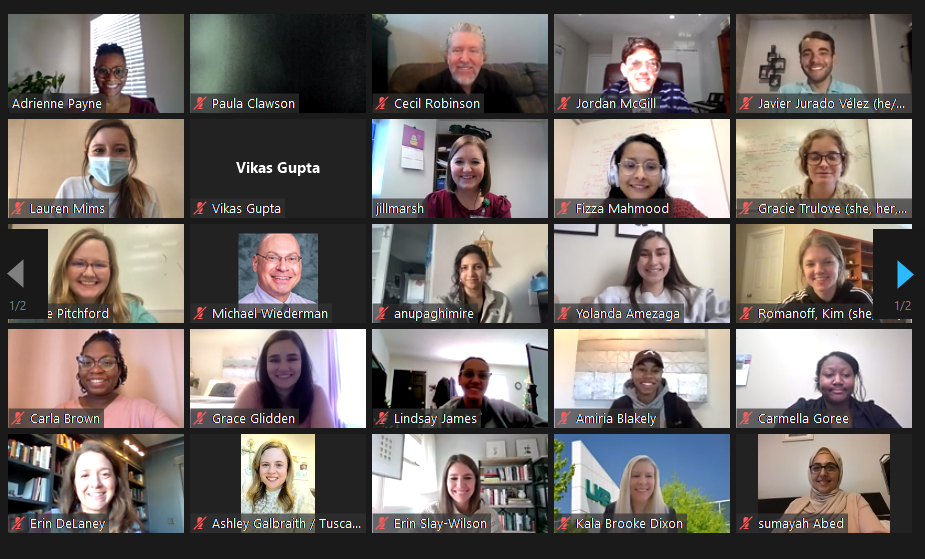
What began as a small, progressive program has quickly grown into a multi-campus initiative aiming to grow the number of primary care providers for the state of Alabama and address critical shortages. Since its launch in 2020, the Comprehensive Urban Underserved and Rural Experience (CU2RE) program has nearly tripled in size, expanded to all of the UAB Heersink School of Medicine’s campuses, and is on track to open a pipeline program for undergraduate students in 2022.
CU2RE, funded by a $7.5 million HRSA grant, is a complex program run by many dedicated physicians, program managers, and staff out of UAB’s Department of Family and Community Medicine.
“We are here to provide meaningful learning experiences where program content is relevant, engaging, and offers an enhanced understanding about the role primary care plays in building strong healthcare systems, positive outcomes, and health equity,” said CU2RE Program Director Adrienne Fowler Payne.
Payne and other leadership note the excitement they feel with the program’s growth in year two. The first cohort of eight students just finished their initial year of programming, and the second cohort, starting in January, brings 15 new students to the program.
“Our students have a strong desire to learn about and address the needs of medically urban underserved and rural patient populations in the state of Alabama,” Payne said. “CU2RE plays a role by offering extracurricular educational opportunities to prepare and guide students to a medical career in primary care. We aspire to continually increase program enrollment and have opportunities to connect with more students in the years to come.”
Extracurricular opportunities include a patient panel, in which students are paired with 10 patients that they will follow over the course of their medical training and serve as health coaches, early clinical training that begins when they start medical school, service learning, and hybrid learning modules that prepare students to become compassionate and innovative primary care leaders. Now that CU2RE is expanding to other campuses, program leaders expect the impact to multiply.
“The growth we have seen in just one year of CU2RE is encouraging,” said Jill Marsh, M.D., director of the rural and urban underserved pathways. “We have engaged deeply-committed family medicine partners at all UAB regional campuses, and the snowball effect of growing our student and faculty cohorts has led to even greater shared excitement about the future of primary care at UAB and for the state of Alabama.”
CU2RE now includes students from all of UAB’s medical campuses. All CU2RE students will spend time learning about primary care and telehealth, studying health disparities, conducting research, and understanding how to provide culturally competent care for different patient populations. The CU2RE team in Birmingham works closely with regional faculty and coordinators to ensure that the CU2RE students receive all the benefits of the program at their campus alongside their CU2RE peers. This model builds continuity and collaboration among UAB’s medical campuses, another goal of the CU2RE grant.
First-year CU2RE students like Laura Catherine Cresswell, from Arab, Alabama, are excited to begin the curriculum in January 2022.
“Primary care is the first line of defense in healthcare,” Cresswell noted when discussing what drew her to primary care in the first place. “It’s most patients’ first interaction with a health care provider, so I think it is very important to make them feel supported to build the foundation.”
Cresswell and other students are paired with a faculty mentor who will work with them one-on-one throughout medical school. Her upcoming mentorship and 10-patient panel are the two program components that most excite Cresswell.
“I liked the idea of having a patient panel that I follow throughout my time in medical school,” she said. “One of the key parts of treating people in rural areas is creating meaningful, long-lasting relationships. I am excited to see this firsthand!”
Similar to Cresswell, first-year medical student Amiria Blakely was drawn to CU2RE because of her passion for primary care and the chance for earlier clinical exposures.
“I am most excited about the hands-on learning experience,” said Blakely. “I’m thankful that I will have the opportunity to work with a set of patients who will allow me to play a role in their health care.”
Blakely will finish medical school at the Tuscaloosa campus, and the CU2RE program will follow her there. She and other Tuscaloosa-bound students will work with program site directors Cecil Robinson, Ph.D., and Grier Stewart, M.D.
Javier Jurado Velez, part of the urban underserved pathway, is ready to learn more about the holistic side of primary care through CU2RE’s integrated curriculum.
“From housing and food access to mental well-being, multiple aspects of a patient's livelihood can accentuate the health inequities they may experience,” he said. “I applied to the CU2RE program since it offered a unique opportunity to work closely with patients from underserved communities in a well-rounded, longitudinal program.”
Velez and the other students have a lot to look forward to, as well as hard work ahead of them as they begin. As the CU2RE program continues to grow, leadership is looking to the future for inspiration and innovation.
“CU2RE, and all its related programming, is a great step for us to take for Birmingham and our state,” said Irfan Asif, M.D. Asif serves as the department chair, professor and associate dean for primary care and rural health in the UAB Heersink School of Medicine. He is also the principal investigator for the CU2RE program grant.
“The program hinges on providing students with early clinical exposures and educational experiences that enforce the innovation that is and must continue to happen in primary care,” he noted. “Telehealth, practice transformation, working well on an interprofessional team—these are all necessary skills for our students to learn as they grow into the next generation of primary care leaders.”
Meet all of the new members of the second CU2RE cohort here.
Beverly VonDer Pool, M.D., Retires After 40-Year Career in Family Medicine, Women’s Health
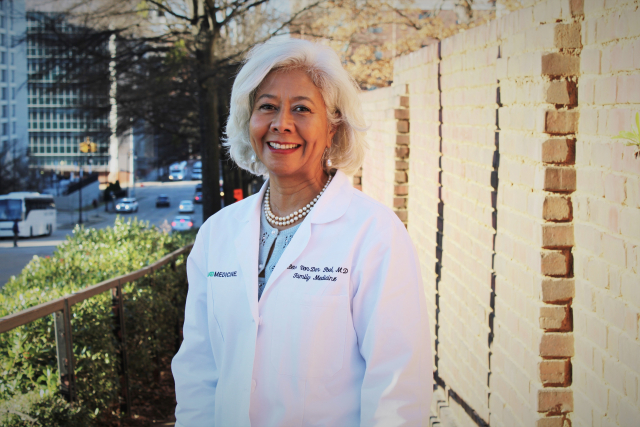
Beverly VonDer Pool, M.D., has enjoyed a career has spanned both coasts and four decades, but her primary goal – improving health for women and families through the practice of compassionate, evidence-based family medicine – has never wavered. She retired at the end of 2021 and colleagues say her legacy stretches from the clinic to the classroom and beyond.
“Dr. VonDer Pool is a pioneer in family medicine. She has been a part of the long history of our department and her impact can be felt through the generations of family physicians that she has trained, as well as the patients who have been cared for by her and those she has educated along the way,” said Irfan Asif, M.D., professor and chair of the Department of Family and Community Medicine and associate dean from primary care and rural health. “In particular, she has had tremendous influence on how we provide women’s health at UAB. We appreciate all that Dr. VonDer Pool has done for us.”
VonDer Pool, an associate professor in the Department of Family and Community Medicine who has most recently practiced at the UAB Highlands Family Medicine clinic, joined UAB in 1992 as the Family-Centered Maternal Care director, a role she held in 2003. In that role, with the help of more than $1 million in training grants and federal Healthy Start grants, VonDer Pool supervised four midwives, many family medicine residents and UAB medical students in the delivery of hundreds of babies. She also joined UAB midwives in providing prenatal and gynecology care to women in Birmingham’s underserved West End, before the West End Health Center was created. In addition, VonDer Pool worked with UAB Maternal-Fetal Medicine, using grant funding from rural health initiatives, to train four family medicine doctors to provide advanced surgical maternity care to rural counties in Alabama.
From 1995 to 2003, VonDer Pool also served as the director of family medicine predoctoral programs at UAB. She helped lead UAB’s Minority Medical Education Program from 1993 to 1999 and was also a board advisor and mentor at UAB for the Robert Wood Johnson Foundation, the nation’s largest philanthropy dedicated solely to health. From 1995-2020, VonDer Pool served annual as director, national adviser and faculty for Advanced Life Support workshops, training Alabama family medicine residents, nurses and physicians for obstetrics emergencies.
VonDer Pool served as the Obstetrics, Women’s and Home Bound Patient Director at Ascension St. Vincent’s East Family Medicine from 2003 to 2020 before returning to the UAB Department of Family Medicine in 2020. Despite her busy teaching, practice and administrative abilities, she continued to make time for house calls on her way home – a rarity in health care today.
VonDer Pool earned her medical degree from the University of California at San Francisco and completed her residency in 1982 at the University of Washington.
VonDer Pool has been repeatedly honored for her work as a physician and as an educator. Among numerous awards, she won an Argus Award, given by UAB medical students to the faculty members and mentors who made particularly powerful contributions to their education. In addition, in 2020, she received a Lifetime Faculty Teaching Award.
She was a member of the American Academy of Family Physicians, the Society for Teachers of Family Medicine and the Alabama Academy of Family Medicine Physicians. She also served on numerous committees and task forces at UAB, including the School of Medicine Admissions Committee Clinical Council, the Student Health Services Task Force, the Women’s Primary Care Resident Focus Group, the Clinical Education Task Force, the Clinical Sciences Subcommittee, the Clinical Academic Committee, the Patient/Family Education Committee, the Professional Rural Leaders Pipeline Committee, OB Clinical Leadership team, and the VIVA UAB Medicaid Obstetrics Quality Assurance Committee.
From 2011 to 2020, VonDer Pool was also a Birmingham Community Board Member for Birth Well Partners, a nonprofit organization that trains community doulas to provide one-on-one support to under-resourced pregnant people in central Alabama.
Fittingly, a phone call from a patient helped VonDer Pool reflect on her career as she neared retirement. On Nov. 7, she received a call from a woman she had diagnosed with a rare obstetric disorder decades earlier. VonDer Pool had helped the woman safely deliver her son, and the woman was calling to thank her again. Her son had just turned 27 that day.
VonDer Pool said she is thankful for “a great family medicine career of service, receiving more joy and gratification from my patients and learners than I ever gave them.”
Erin DeLaney, M.D., assistant professor, vice chair of clinical affairs and quality, medical director of UAB Family and Community Medicine – Highlands, where VonDer Pool recently practiced, said her legacy will continue for years to come.
“Dr. VonDer Pool has made a significant contribution to the field of family medicine through her decorated career. She is a rare gem in primary care – practicing full-spectrum family medicine with an emphasis on women’s health and obstetrics. Not only did she provide her patients with genuine and excellent care she was able to teach the next generation of primary care physicians through her superb knowledge and art. Her legacy will live on through the lives of all those she met and cared for – patients, colleagues, students, residents and friends. Few will be missed as much as Dr. Beverly VonDer Pool.”
That’s a Match! Department Welcomes Two New Sports & Exercise Medicine Fellows
Wednesday was Match Day across the country for aspiring sports and exercise medicine physicians and two new fellows, Anthony D’Onofrio, D.O., and Jesse Gettinger, M.D., officially joined the UAB Sports & Exercise Medicine Fellowship.
Sponsored by the Department of Family and Community Medicine, the ACGME-accredited fellowship combines comprehensive sports medicine training with opportunities in exercise and lifestyle medicine and family medicine practices. It is part of the UAB Sports & Exercise Medicine program, a partnership between the departments of family and community medicine, orthopaedics and physical medicine and rehabilitation.
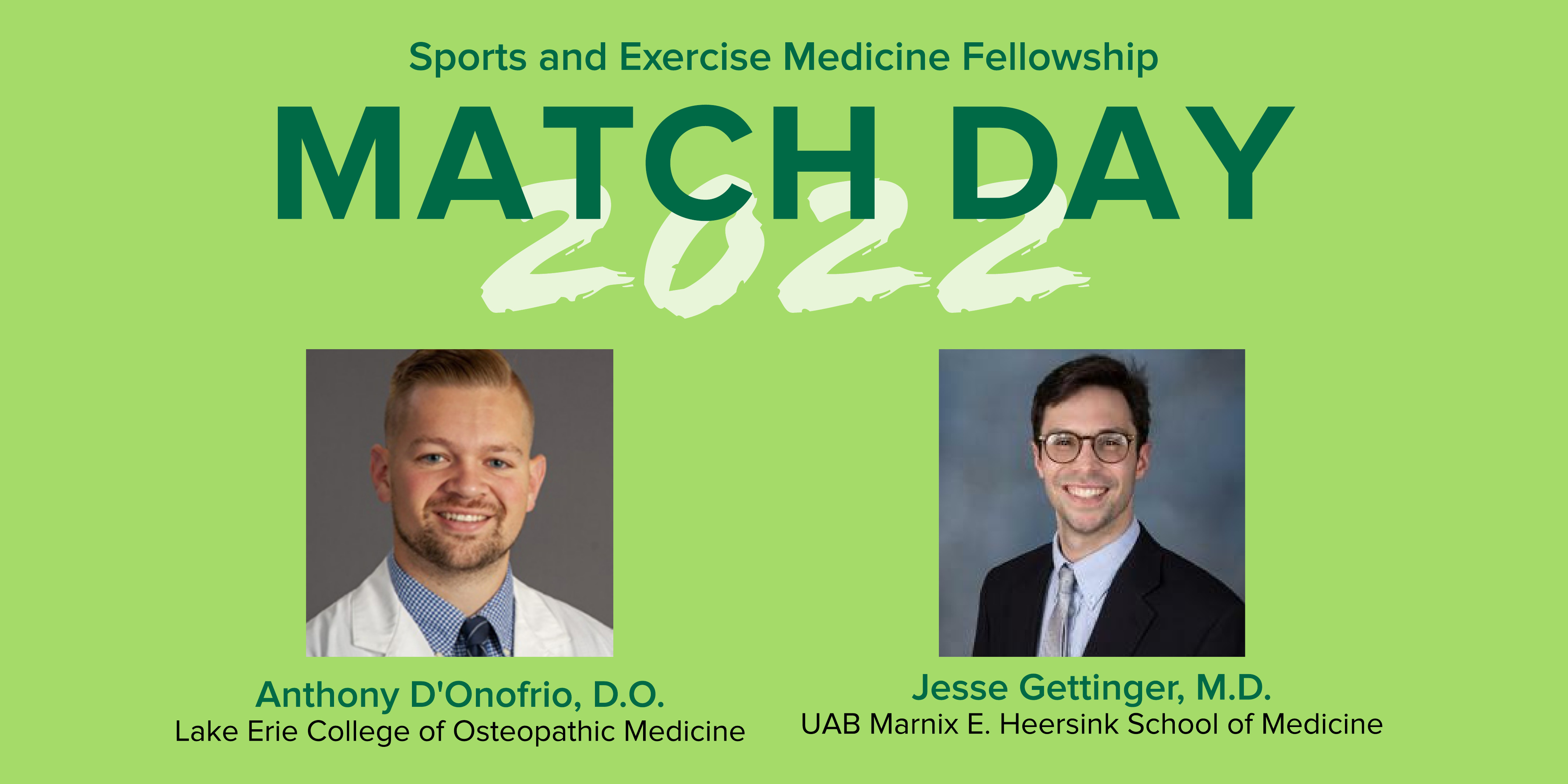
Unlike many other fellowships, UAB’s Sports & Exercise Medicine Fellowship is a two-year program and includes the opportunity to earn a Master of Science in Exercise and Nutrition. That degree, combined with the hands-on clinical experience fellows receive in UAB's family medicine clinics, prepares fellows to be well-rounded physicians, well versed not only in sports medicine but in exercise, nutrition and family medicine.
UAB fellows also get the opportunity to work directly with athletes at every level, from youth sports to UAB student-athletes to some of Birmingham’s most competitive professional teams, as the UAB Sports & Exercise Medicine program provides on and off-field care for the Birmingham Legion FC, Birmingham Bulls hockey, Birmingham Vulcans Rugby and others. This year's fellows will also join as the UAB Sports & Exercise Medicine program cares for athletes in The World Games 2022, which will bring thousands of elite athletes to Birmingham.
“The combination of opportunities we are able to offer at UAB makes for a really unique and rigorous fellowship program, and we are so excited to welcome Drs. D’Onofrio and Gettinger to that experience,” said Ian McKeag, M.D., M.S., assistant professor and director of the fellowship program. “Both of them really stood out during the interview process and I am thrilled that they will be joining us in Birmingham.”
D’Onofrio completed his medical education at Lake Eri College of Osteopathic Medicine and his undergraduate education at Saint Vincent College in Pennsylvania. He received several scholarships and awards in medical school, including the Michael J. Feinstein, D.O., Family Medicine Award for dedication to primary care. He is a member of the American Academy of Family Physicians and the American Medical Society for Sports Medicine.
Gettinger is an alumnus of the UAB Heersink School of Medicine, where he graduated in 2019, and earned his undergraduate degree from the University of Alabama. He is a member of Alpha Omega Alpha, a national medical honor society, and the American Medical Society for Sports Medicine. While in medical school, he received a research grant from the Infectious Disease Society of America for a summer project, among other honors.
The new fellows will join the UAB Sports & Exercise Medicine program this summer. Matthew Miesch, M.D., and Christian Muller, D.O., are currently fellows in the program. You can learn more about their work and the Sports & Exercise Medicine Fellowship here.
